From the bustling streets of Hanoi to the lantern-lit charm of Hoi An, Vietnam captivated us with its unforgettable blend of culture, cuisine, and natural beauty. Picture yourself savoring steaming bowls of pho, gliding through the serene waterways of Tam Coc, or hiking Hang Mua Cave for breathtaking panoramic views—every moment in Vietnam felt like an adventure straight out of a dream.
This guide embodies our mid-paced travel philosophy—balancing immersive experiences with a relaxed pace—to help first-time visitors explore Vietnam thoughtfully. As an Ultimate Travel Guide of Vietnam for First-Timers, it’s packed with essential tips, must-visit destinations, and insider highlights to make your journey seamless and truly unforgettable.
Table of Content
- Getting Started: Vietnam at a Glance
- Top Reasons to Visit Vietnam: Landscapes, History, and Cuisine
- Top Destinations in Vietnam: Highlights and Unforgettable Experiences
- Recommended Vietnam Itinerary for First-Timers: Highlights and Overview
- Extra Itinerary Tips for First-Timers Planning a Vietnam Adventure
- Vietnam Travel FAQs for First-Timers: Transportation, Language, and More
- Getting to Vietnam: International Airports and Travel Options
- Exploring Vietnam: Transportation Tips for First-Timers
- Navigating Vietnam’s Traffic for First-Timers: What You Need to Know
- Traveling in Vietnam with Just English: What to Expect
- Staying Healthy: Food Safety Tips for Your Vietnam Adventure
- Money in Vietnam: Essential Tips for First-time Travelers
- Budgeting for Vietnam: How Much Does It Cost to Travel in Vietnam?
- Additional Practical Tips for First-time Travellers in Vietnam
Getting Started: Vietnam at a Glance
This section of the Vietnam Travel Guide for First-Timers provides essential insights to help you familiarize yourself with the country’s unique attributes and prepare for an unforgettable journey.
Quick Facts about Vietnam for First-Timers
Before your Vietnam adventure, here are key details about the country to set the stage for your journey.
- Capital City: Hanoi
- Population: ∼100 million
- Geography: A long, narrow country in Southeast Asia bordered by China, Laos, Cambodia, and the South China Sea.
- Language: Vietnamese (official language). English is widely spoken in the tourist industry and popular tourist areas.
- Currency: Vietnamese Dong (VND)
- Best Time to Visit: The dry season (December to April) is generally the best time to visit Vietnam, offering clear skies, a drier climate, and pleasant temperatures. If you prefer fewer crowds, the transitional seasons (May to June and October to November) are a good alternative, with a mix of sunny days and occasional light rain. While the weather during these periods can be variable, humidity levels—though high—are rarely extreme.
- Safety: Vietnam is generally safe, but petty theft can occur in busy areas. Be especially cautious of chaotic traffic in cities like Hanoi and Ho Chi Minh City. For tips on navigating traffic, see the FAQ section at the end of this guide.
Vietnam’s Regions: A Guide to Planning Your Trip
Vietnam is divided into three distinct regions, each offering unique experiences for travelers. Understanding these regions can make a significant difference when planning your trip—helping you decide the best time to visit, match your interests with what each region offers, and manage weather conditions to ensure a smooth and enjoyable journey.
- Northern Vietnam: Known for its cooler climate and dramatic landscapes, this region features iconic destinations such as Hanoi, Ha Long Bay, Ninh Binh, and Sapa. If you enjoy breathtaking natural beauty, mountain hikes, and cultural landmarks, Northern Vietnam offers a perfect mix. Best Time to Visit: November to March during the dry season, when the weather is mild, skies are clear, and the landscapes are lush and vibrant.
- Central Vietnam: Steeped in history, Central Vietnam is home to the imperial city of Hue, the vibrant coastal city of Da Nang, and the charming Ancient Town of Hoi An. This region is ideal for history lovers and travelers seeking a mix of cultural exploration and beach relaxation. Best Time to Visit: January to April offers warm, sunny weather during the dry season—perfect for sightseeing and coastal activities. May to August can also be a good alternative if you can manage the heat.
- Southern Vietnam: While not covered in this guide, Southern Vietnam boasts bustling Ho Chi Minh City, the lush Mekong Delta, the countryside charm of Da Lat, and idyllic island getaways like Phu Quoc. Best Time to Visit: December to April during the dry season, when temperatures are more comfortable and rainfall is minimal.
How Knowing the Regions Helps Plan Your Trip
- Timing: Each region requires roughly a week to explore at a mid-paced travel style. By understanding the size and highlights of each region, you can allocate your time efficiently and avoid feeling rushed.
- Matching Interests: Whether you love nature, history, food, or coastal relaxation, each region excels in different experiences. For example, Northern Vietnam is perfect for mountain lovers and nature enthusiasts, while Central Vietnam caters to history buffs and beachgoers.
- Weather Considerations: Vietnam’s climate varies significantly across regions. In late spring, the Northern and Central regions can be hot and humid but still manageable with a slower-paced itinerary. In contrast, the Southern region’s heat during these months can feel intense and overwhelming—a key reason we chose to focus on the North and Central regions during our early June visit.
By understanding these regional differences and planning accordingly, you can make the most of your trip—maximizing comfort, aligning your itinerary with your interests, and enjoying the best weather conditions for each area. For our trip in early June, focusing on Northern and Central Vietnam allowed us to manage the heat while fully immersing ourselves in its culture, landscapes, and rich history without feeling rushed.
Vietnam’s Fascinating History: What to Know Before Your First Visit
Vietnam’s history is a rich tapestry of dynasties, colonial rule, and modern unification that continues to shape the nation’s identity. Over a millennium of Chinese rule left a profound impact on Vietnam’s culture, governance, and language. This influence is especially evident in its Confucian ideals and traditional architecture.
The 19th century saw Vietnam fall under French colonial rule, which introduced European-style buildings, Catholicism, and Western education while fueling resistance movements like those led by the legendary Ho Chi Minh. During our visit to Hue, we explored the Imperial Citadel, which offered a fascinating look into Vietnam’s royal history and resilience through various eras.
The mid-20th century brought the Vietnam War, a devastating conflict that left deep scars but ultimately led to the country’s reunification in 1975. Today, Vietnam stands as a testament to resilience, with its historic landmarks, vibrant cities, and enduring traditions offering visitors a chance to connect with its complex and inspiring past.
Top Reasons to Visit Vietnam: Landscapes, History, and Cuisine
From breathtaking natural landscapes to a rich historical narrative and mouthwatering cuisine, Vietnam offers a multi-sensory experience that leaves visitors in awe. Whether you’re seeking adventure, cultural immersion, or a foodie escape, Vietnam will surely exceed your expectations. Here are the top reasons why we loved Vietnam and why we believe it deserves a spot on your travel list:
- Stunning Landscapes: Vietnam’s natural beauty is unparalleled, from the limestone karsts of Ha Long Bay to the majestic Marble Mountains in Da Nang. These iconic landscapes provide endless opportunities for photography, relaxation, and adventure. One of our most cherished memories was exploring Tam Coc—gliding through tranquil waterways on a traditional boat, surrounded by lush rice paddies and towering limestone cliffs. It felt like stepping into a living painting, a magical experience that perfectly captures the serene beauty of Vietnam.
- Rich History: Ancient temples, imperial cities, and poignant war relics tell the story of a nation shaped by centuries of dynasties, colonization, and resilience. Exploring Hue’s Imperial Citadel offered us a glimpse into the grandeur of Vietnam’s royal past, while wandering through Hoi An’s lantern-lit Old Town transported us to a bygone era. These historical treasures make Vietnam a must-visit for anyone fascinated by culture and history.
- World-Class Cuisine: Vietnam is a foodie’s paradise, offering a tantalizing journey through its rich culinary traditions. We savored each meal slowly, immersing ourselves in local food cultures at our own relaxed pace. From steaming bowls of pho in bustling Hanoi street markets to fresh seafood by the coast in Da Nang, every dish was a thoughtful and flavorful experience. Vietnam’s cuisine is not just about food; it’s about connecting with its vibrant culture one bite at a time.
- Affordable Travel: Vietnam is incredibly budget-friendly, offering exceptional value without compromising on quality. Whether you’re enjoying a luxurious overnight cruise in Ha Long Bay, staying in charming boutique hotels, or sampling delicious street food, every dollar stretches further here. Traveling in Vietnam allows you to indulge in unique experiences, luxury, and adventure at a fraction of the cost compared to other destinations.
Vietnam truly delivers a perfect balance of natural beauty, cultural depth, and gastronomic delight. It’s a country where every day brings new discoveries and lasting memories—one that continues to inspire and enchant long after your journey ends.
Top Destinations in Vietnam for First-Timers: Highlights and Unforgettable Experiences
Vietnam is brimming with treasures, but a few destinations stood out as the true stars of our journey. From serene landscapes to vibrant cities, these highlights showcase the country’s stunning diversity and left us with memories to last a lifetime. Here’s our list, ranked by their impact on us, along with the experiences that made them truly special:
1. Ha Long Bay: Vietnam’s Crown Jewel (★★★★★)
Suggested Time: 2-3 Days
Ha Long Bay’s emerald waters and dramatic limestone karsts make it Vietnam’s crown jewel and a UNESCO World Heritage Site. Setting sail on a luxury cruise was a dream come true, offering panoramic views, gourmet meals, and a tranquil escape from the city bustle.
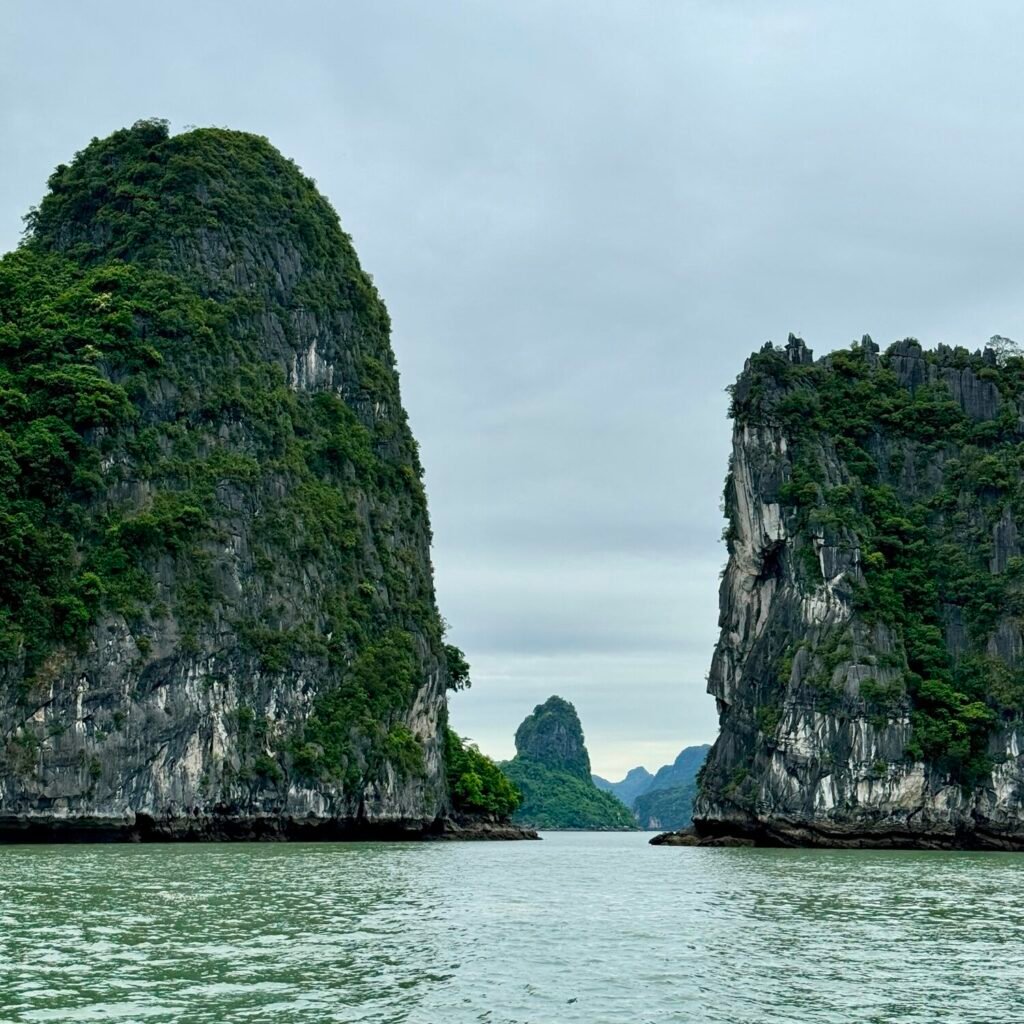
Must-Do Activities:
- Book a luxury cruise with an overnight stay to fully experience the bay. Opt for 3 days and 2 nights for a relaxed pace, or 2 days and 1 night if you’re short on time.
- Explore Surprise Cave, known for its vast chambers and intricate stalactites.
- Kayak through the serene waters of Lan Ha Bay, surrounded by lush cliffs and natural beauty.
- Join a Tai Chi lesson at sunrise on the cruise deck for a peaceful start to your day.
- Watch the sunset during Happy Hour, a magical moment of tranquility.
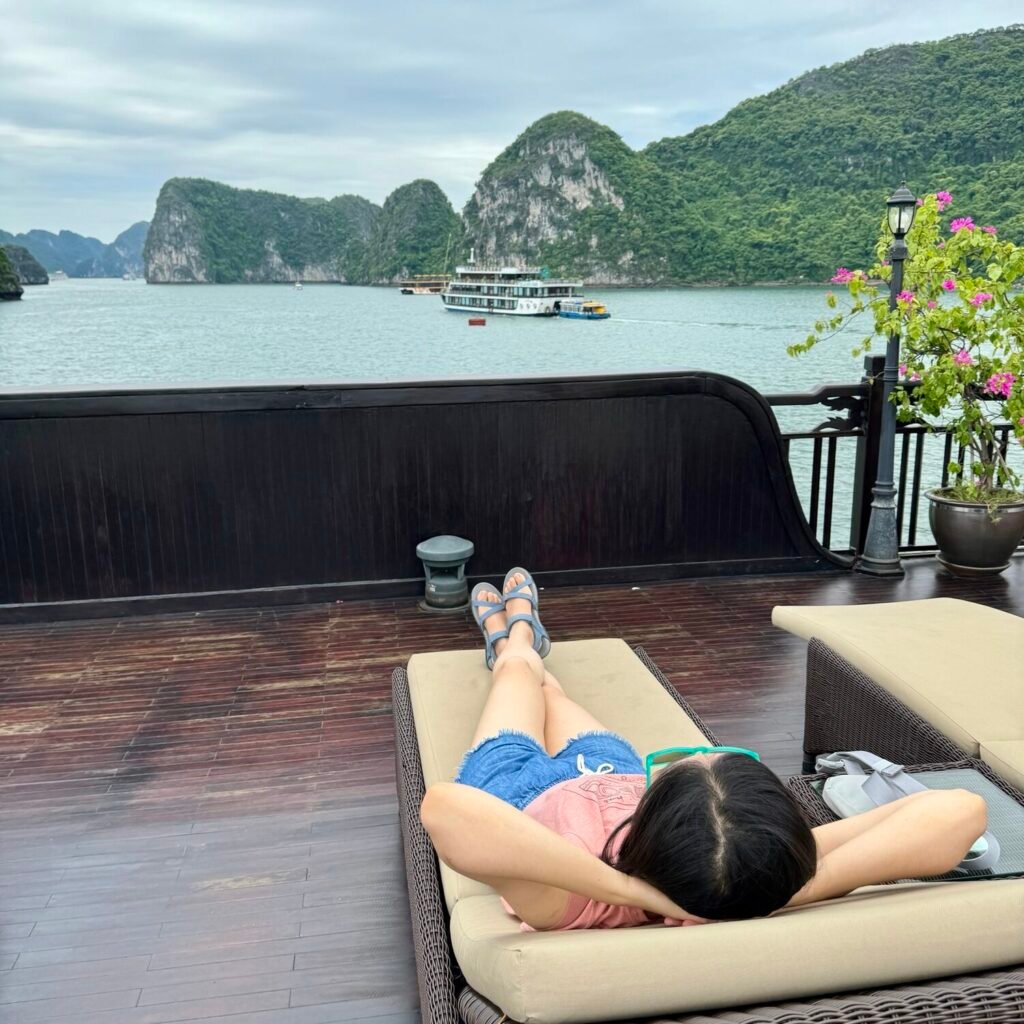
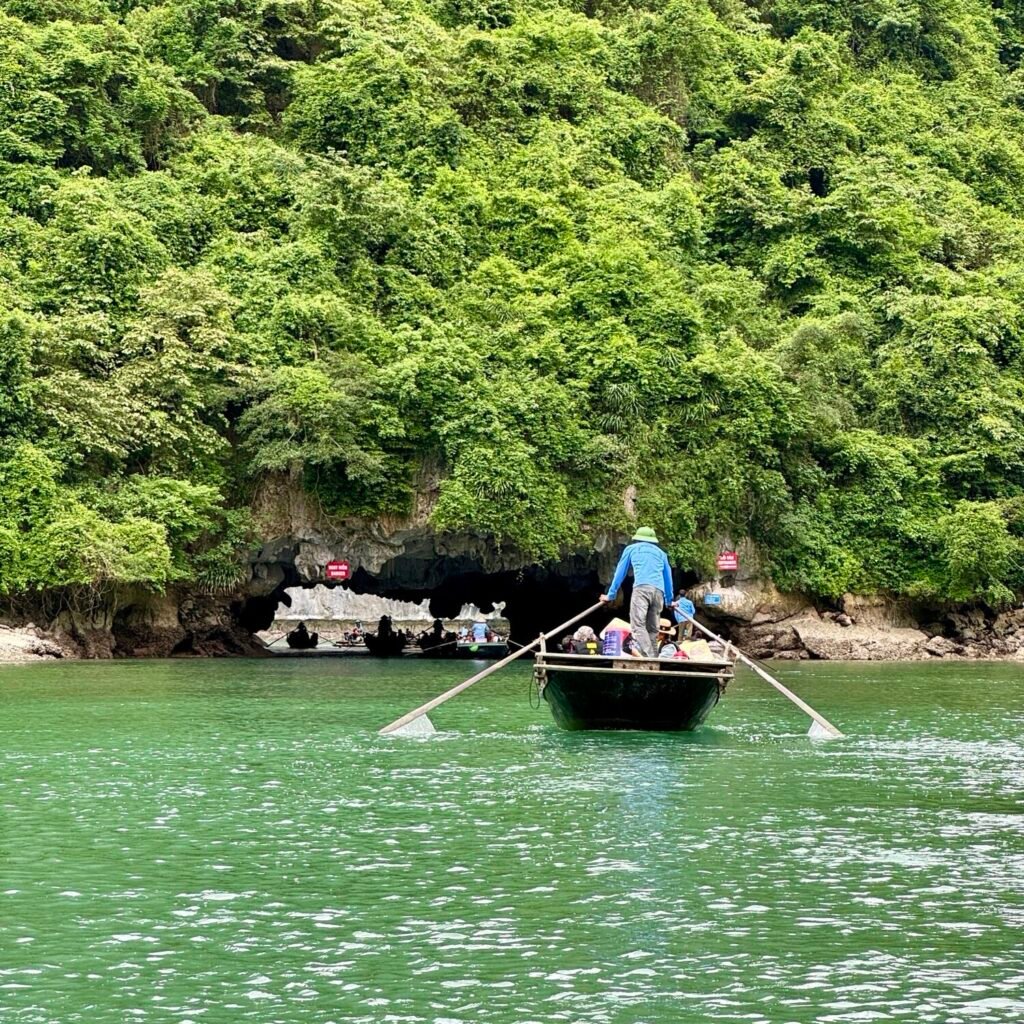
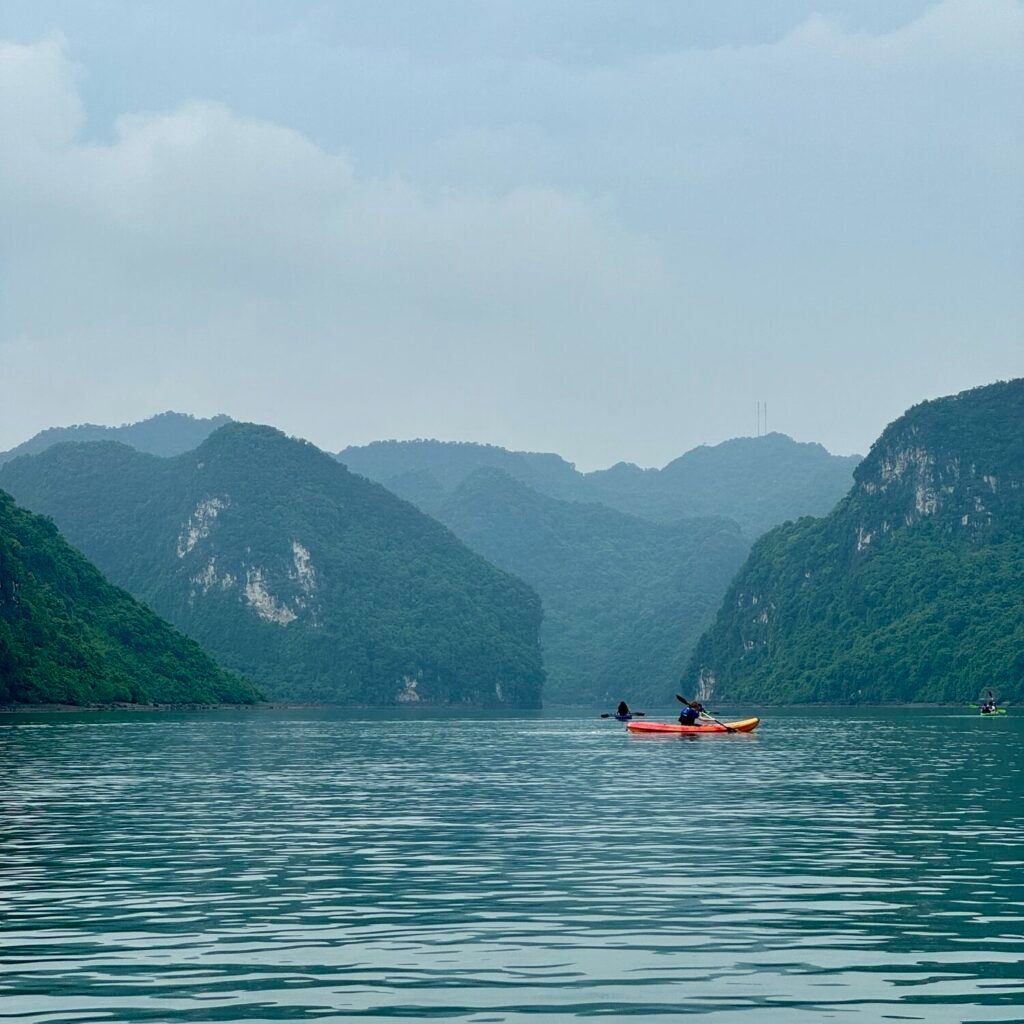
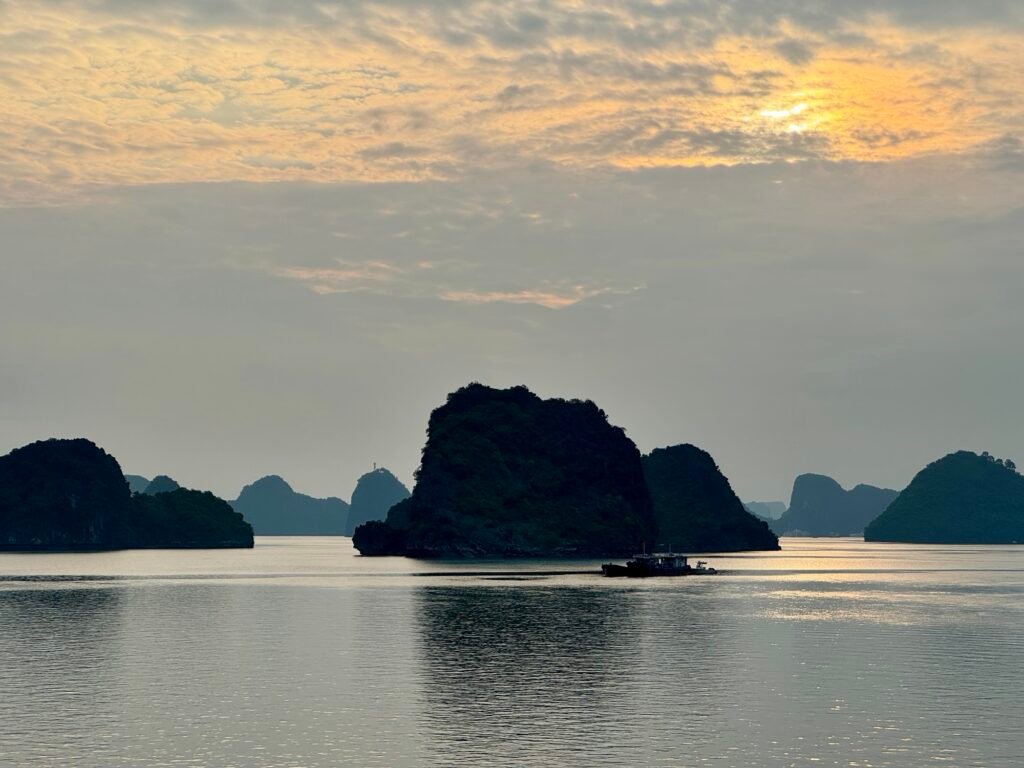
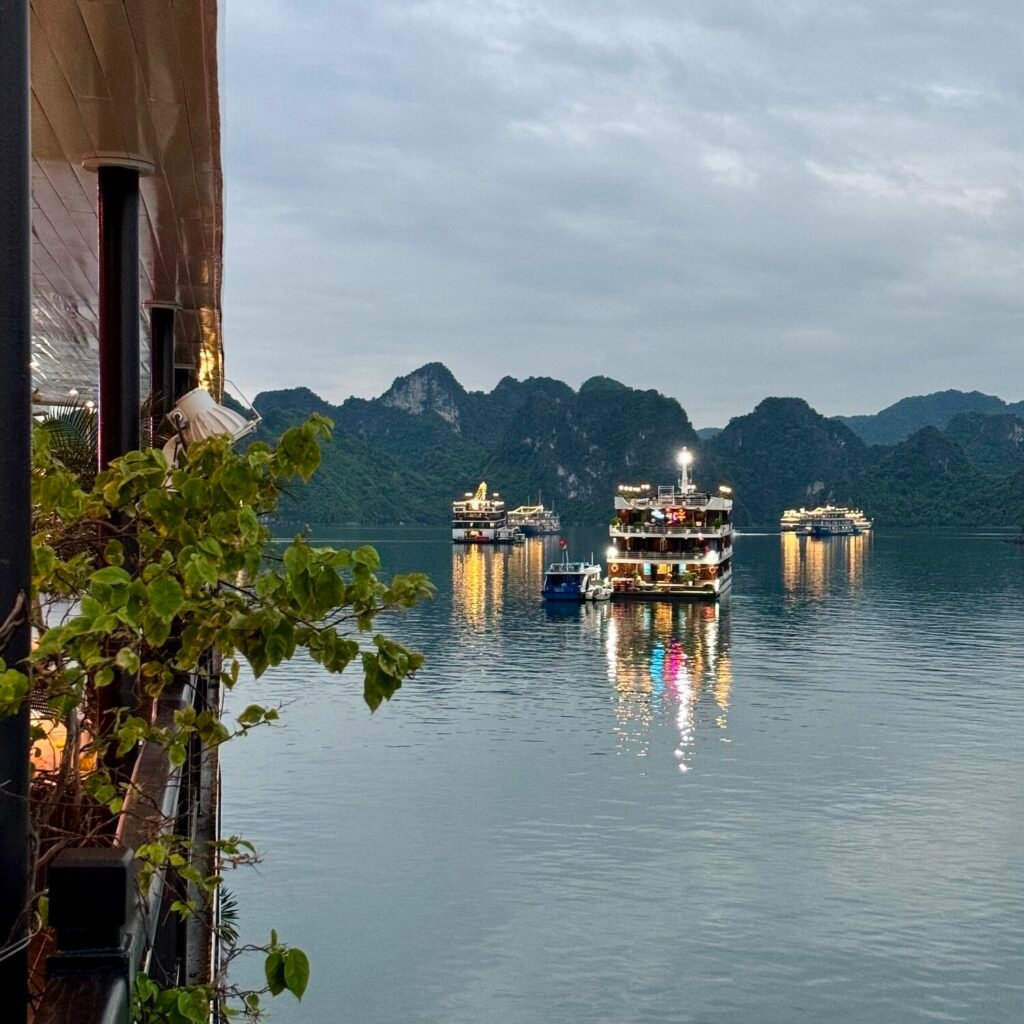
Must-Eat Foods:
- Enjoy freshly caught seafood onboard, such as grilled prawns or lobster, paired with flavorful local dipping sauces.
- Try the cruise’s take on traditional Vietnamese spring rolls or refreshing papaya or lotus root salad.
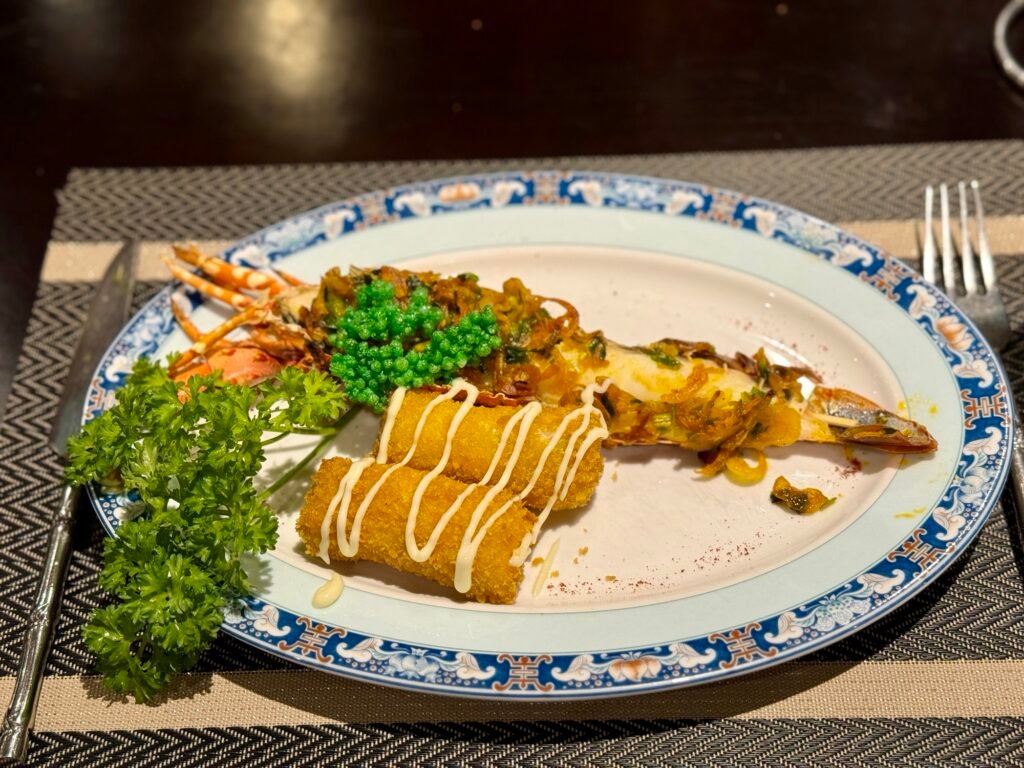
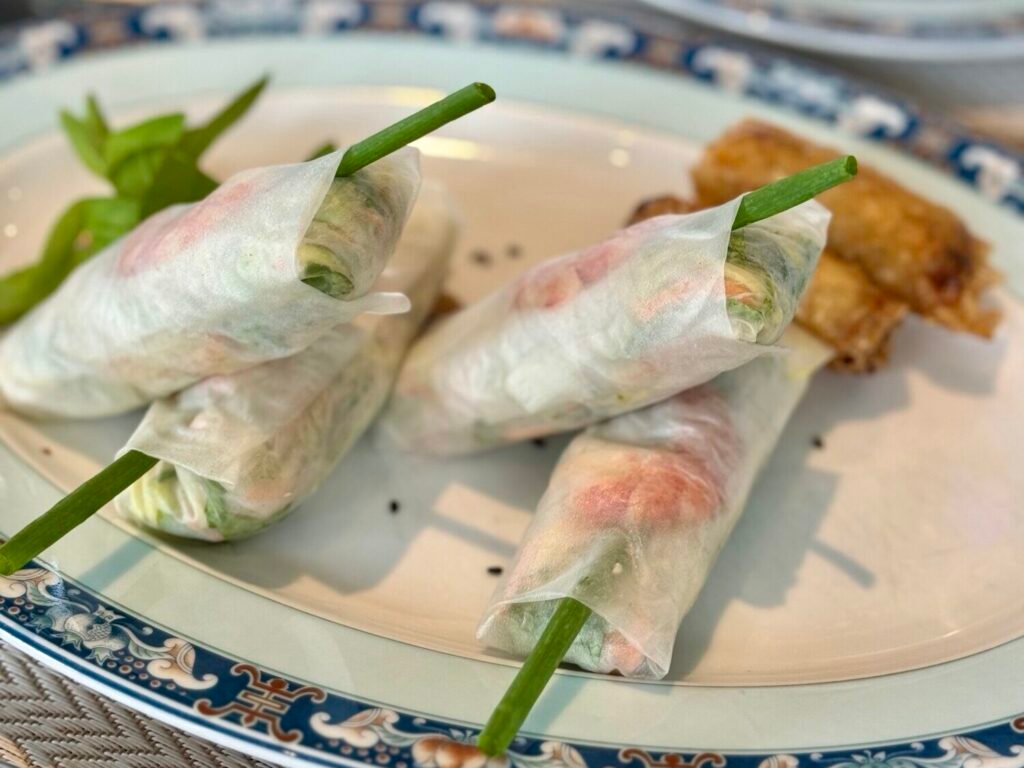
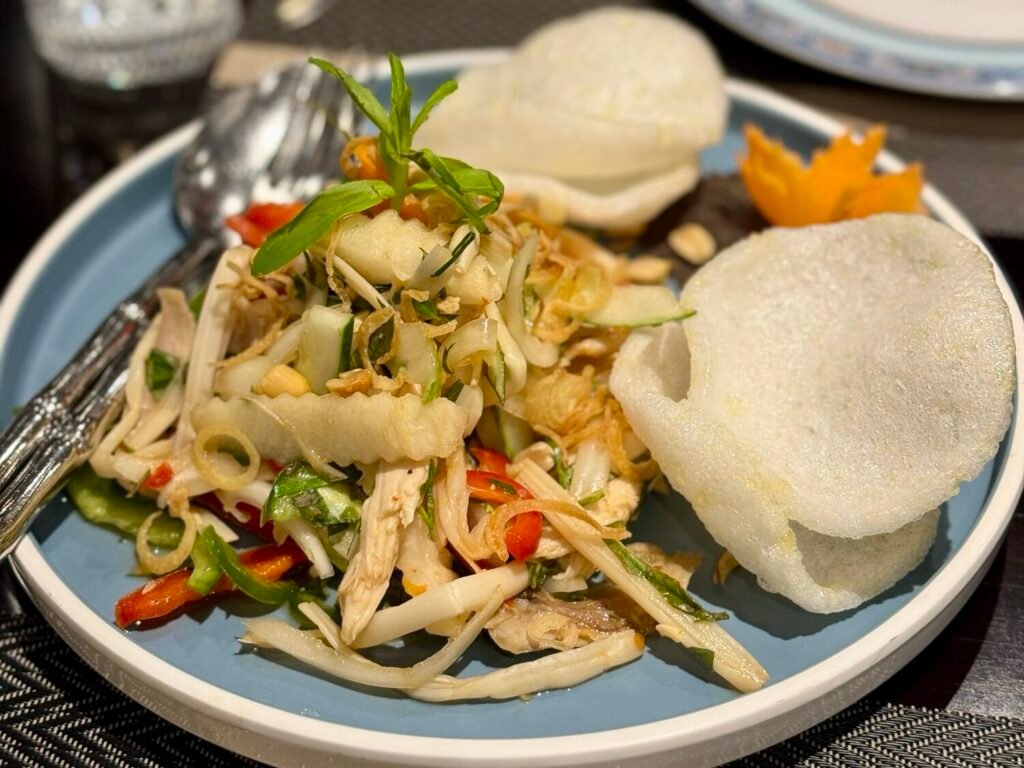
Travel Tips for Ha Long Bay Cruise:
- We highly recommend booking a cruise that includes both Ha Long Bay and Lan Ha Bay. Lan Ha Bay is technically part of Ha Long Bay but is quieter and better preserved. It offers a more serene and less crowded experience, as Ha Long Bay has faced pollution issues due to over-tourism in the past. Not all cruise companies have a license to sail in Lan Ha Bay, so check carefully before booking.
- We sailed with Genesis Luxury Regal Cruise and had an excellent experience. In addition to the scenic route, we particularly appreciated the ship’s new condition, its vintage-style interior room design, and the fact that every room had external-facing windows. The dining experience stood out as well, with a set seafood menu instead of a buffet-style meal, which enhanced the overall sense of luxury and personalization.
2. Tam Coc: Vietnam’s ‘Ha Long Bay on Land’ (★★★★★)
Suggested Time: 2-3 Days
Nicknamed ‘Ha Long Bay on Land’, Tam Coc, located in the picturesque Ninh Binh Province of northern Vietnam, captivates us with its lush rice paddies, serene waterways, and towering limestone peaks. As one of the most iconic destinations in Ninh Binh, Tam Coc offers a tranquil escape that feels like stepping back in time—riding a traditional boat through its winding waterways evokes the charm of a classic Chinese painting or movie. This vintage, adventurous, and romantic experience, combined with Tam Coc’s quiet allure and breathtaking beauty, makes it an undeniable highlight of our Vietnam trip.
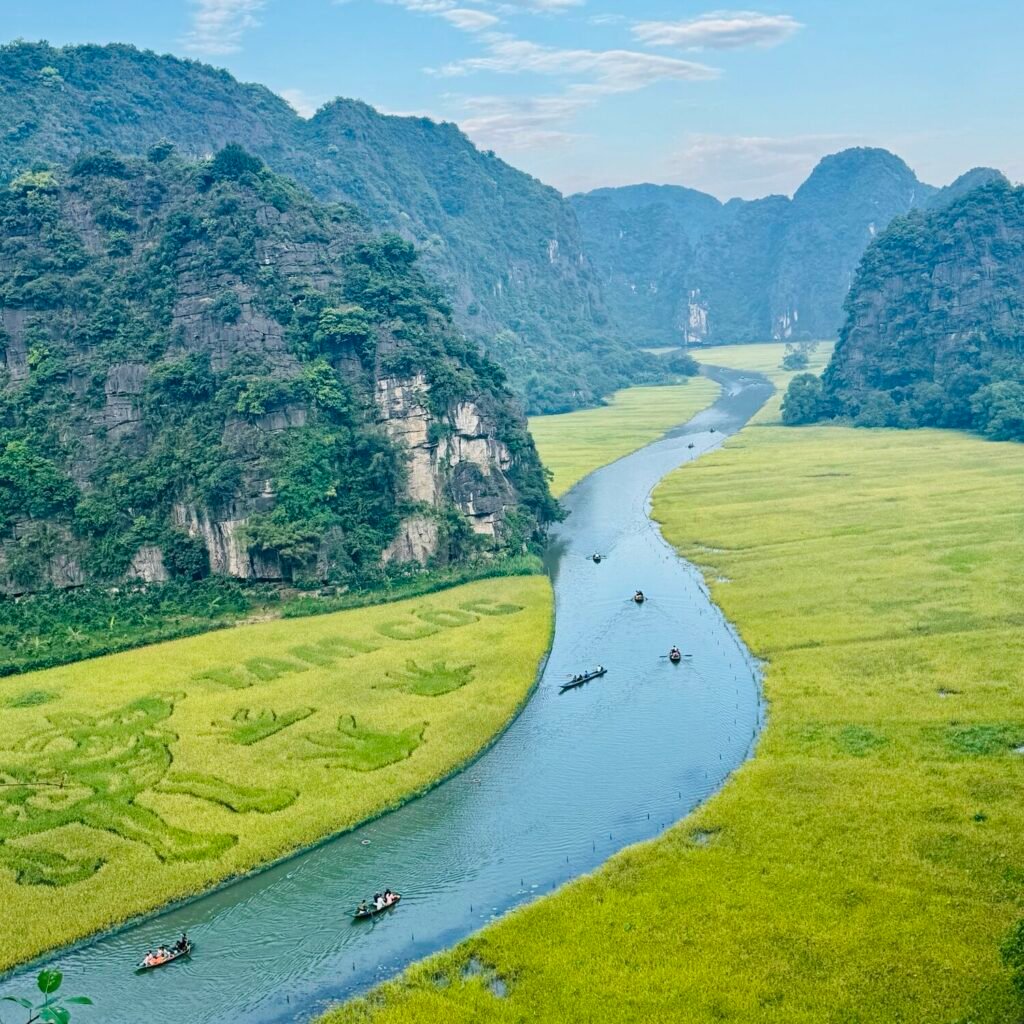
Must-Do Activities:
Tam Coc offers a range of activities that immerse you in its tranquil landscapes and rich history. Whether by boat, bike, or on foot, here are the activities you shouldn’t miss.
- Take a traditional boat ride along the Ngo Dong River, passing through the iconic Three Caves: Hang Ca Cave, Hang Ha Cave, and Hang Ba Cave. (Fun fact: “Tam Coc” means “Three Caves” in Vietnamese.)
- Stop along the river at two hidden gems:
- Gioi Ravine: Climb 150 steep steps for an unforgettable bird’s-eye view of the river winding through golden rice fields.
- Temple of Quy Minh Dai Vuong: A peaceful, lesser-known temple showcasing traditional Vietnamese architecture.
- Hike up Hang Mua Cave for breathtaking panoramic views of the rice fields and winding rivers. Don’t miss the beautiful lotus fields at the cave’s base.
- Bike through the countryside to Bich Dong Pagoda, a serene, three-tiered temple complex built in the 15th century. Nestled in the mountains, it offers breathtaking views and serves as a significant spiritual site for locals.
- Visit Bai Dinh Pagoda, Vietnam’s largest pagoda complex, where you can explore impressive architecture, serene courtyards, and vast gardens.
- Watch the sunset near the Tam Coc main boat launch area after your boat ride—a magical way to end the day.
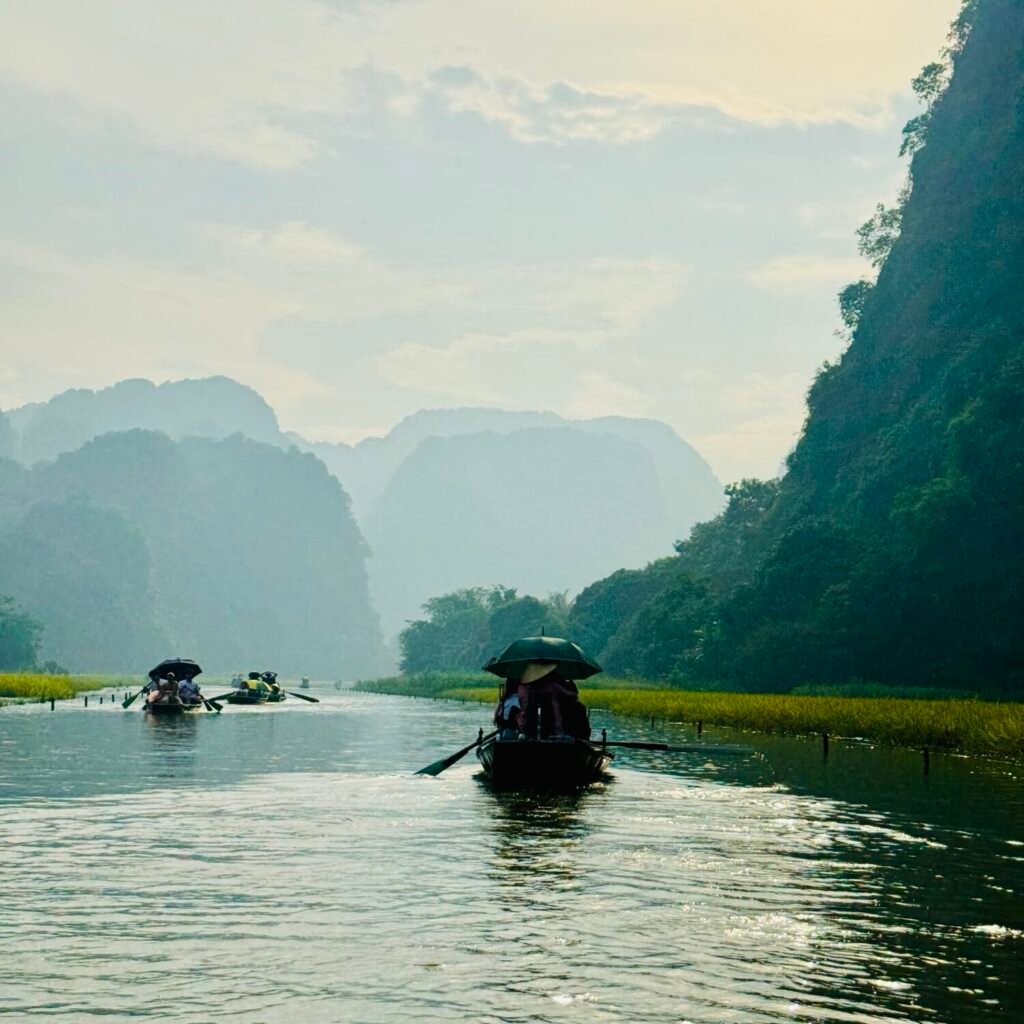


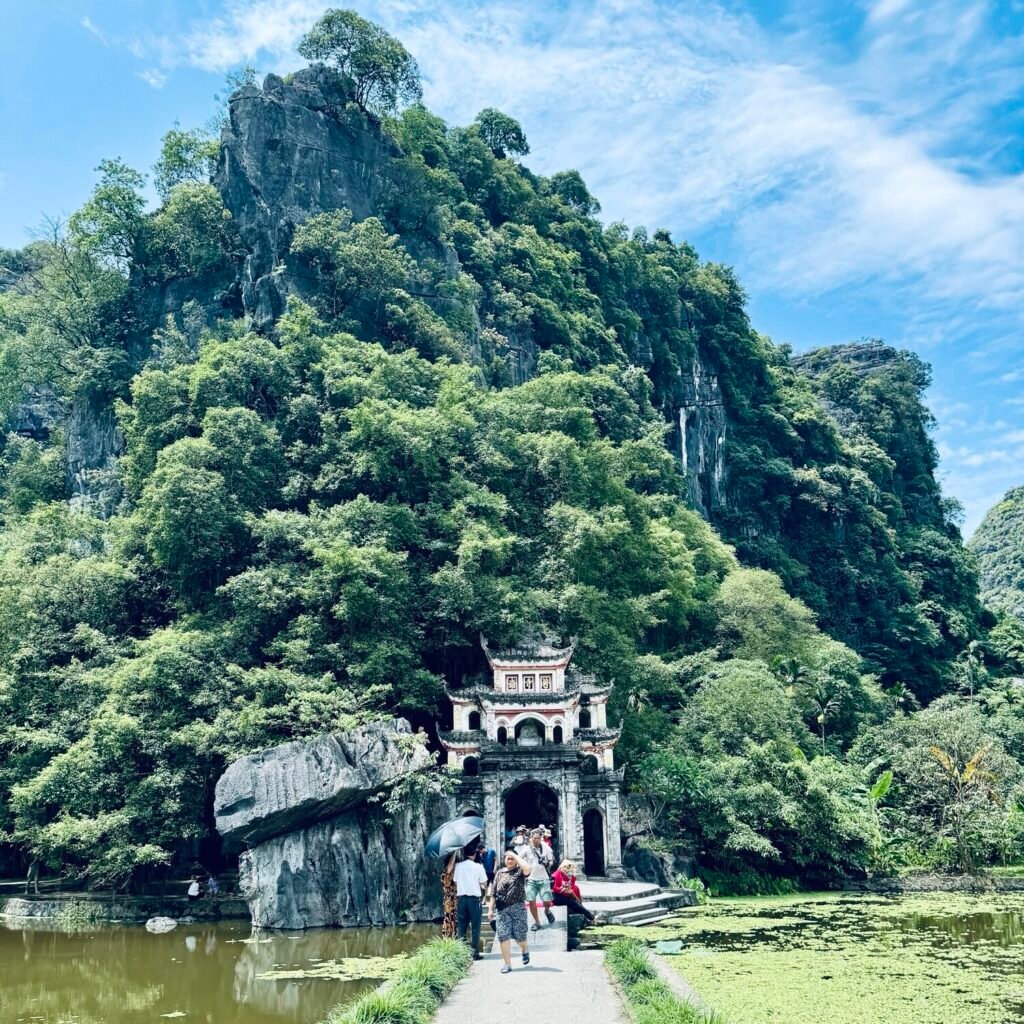


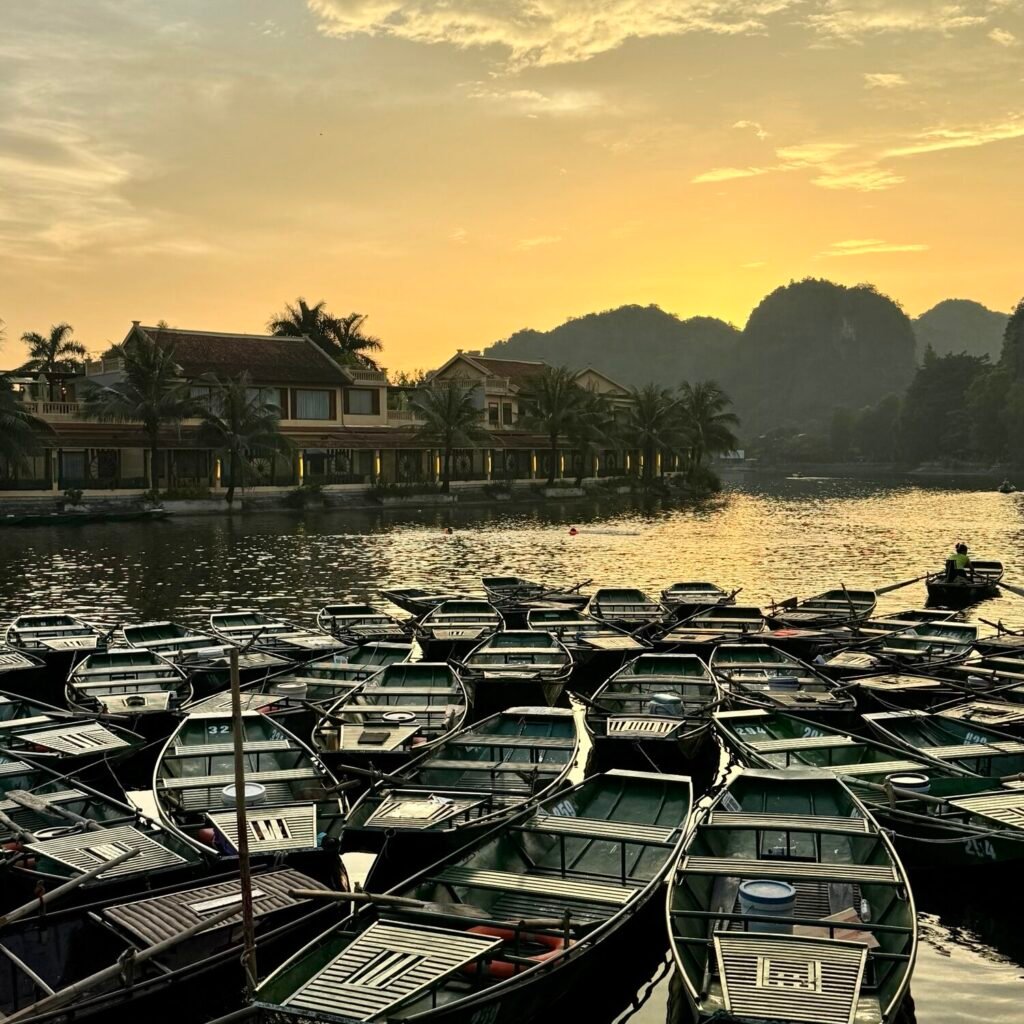
Must-Eat Foods:
Tam Coc is a food lover’s delight, offering dishes that highlight the region’s flavors.
- Roasted duck paired with tangy sauces. Our favorite place to enjoy this dish in Tam Coc is Chef Hien, located on the main street of the town- their fresh local beer is super refreshing and cheap, too!
- Stir-fried morning glory with garlic, a classic Vietnamese vegetable dish
- Braised fish with gao fruit, one of the rustic dishes of people in the region with a distinct sour and fragrant profile
- Fresh or fried spring rolls filled with shrimp and herbs
- Tofu stir-fried with vegetables for a lighter option
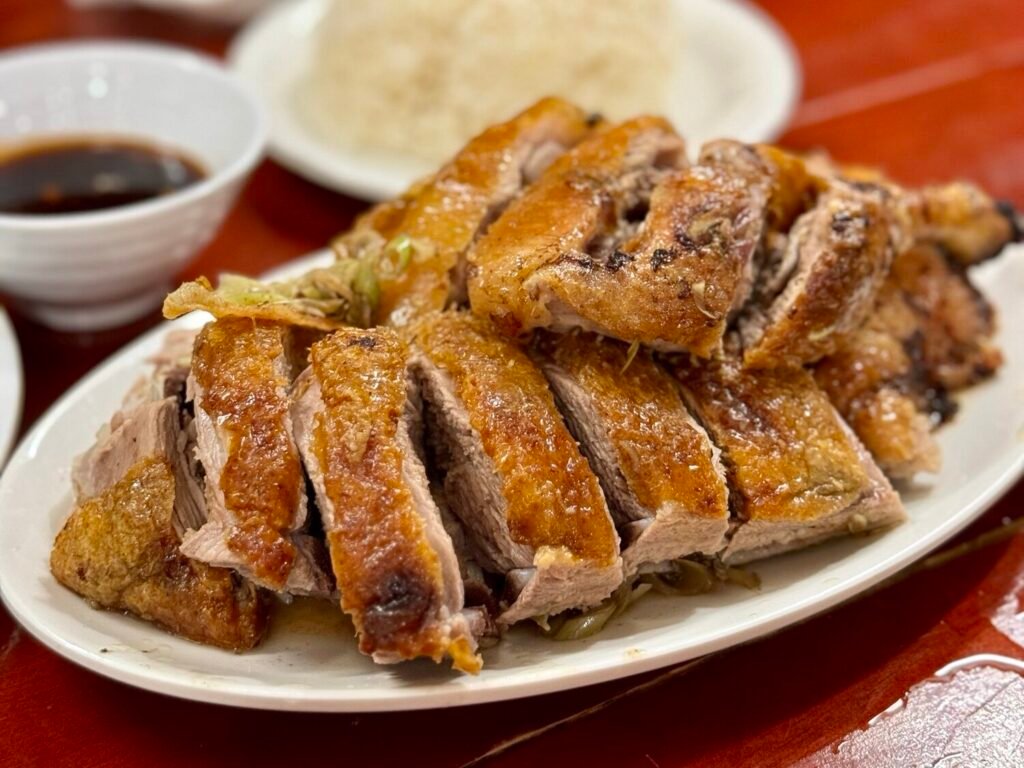
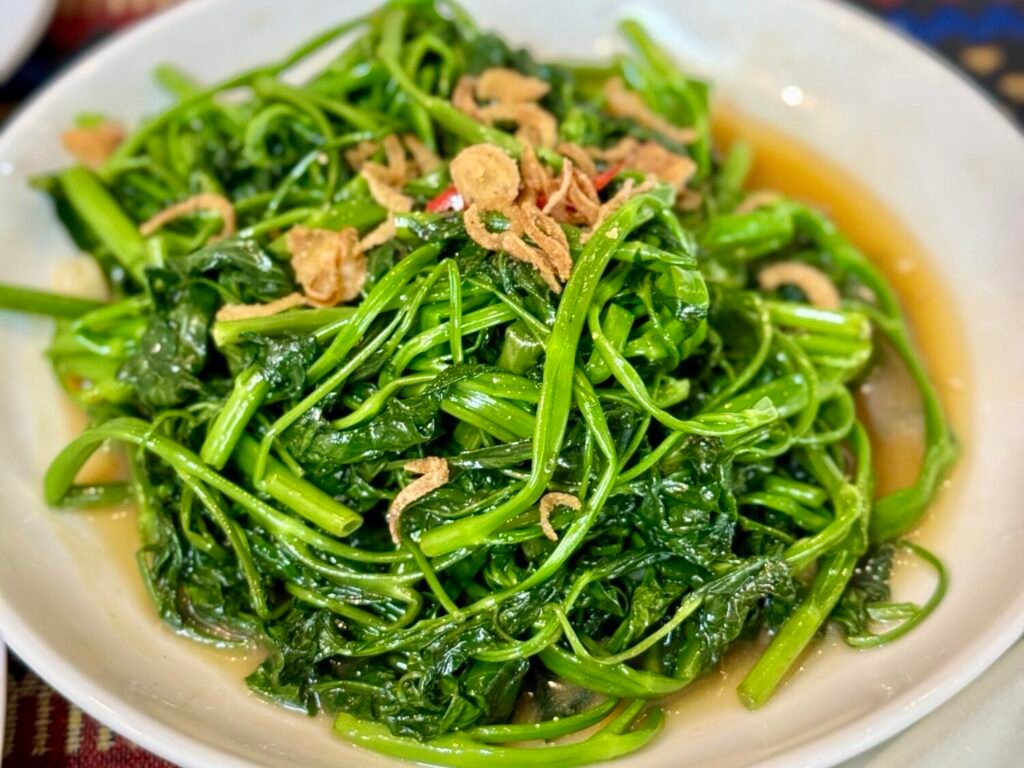

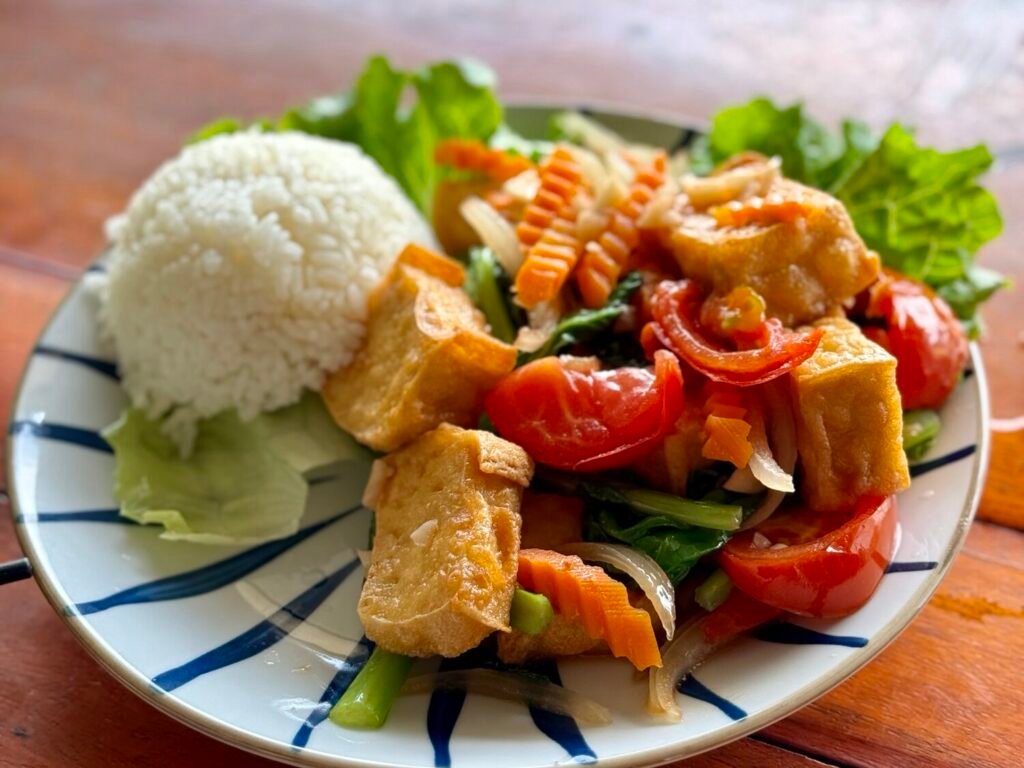
Travel Tips for the Ngo Dong River Boat Ride:
- Tickets: Purchase tickets at the port’s booths, where boats are assigned. Foreign travelers are limited to two people per boat.
- Tipping: While some rowers may request tips, it’s optional and not encouraged by officials. If your rower goes above and beyond, such as waiting for an extended time while you explore stops, a small tip can be a thoughtful gesture. Use your discretion.
Travel Tips for Tackling the Hang Mua Cave Hike:
- Two Scenic Views: The hike has two main viewpoints—one leads to a pagoda overlooking the rice fields and rock formations, and the other offers a stunning view of the river and boats below.
- Start Early: Arrive at dawn to beat the heat and avoid large tour groups, which typically arrive by 10 a.m.
- Stay Sun Smart: Bring water, sunscreen, and a hat, as the trail is completely exposed to the sun. There’s a small shop halfway up offering drinks, ice cream, and a shady place to rest.
Travel Tips for Visiting Bai Dinh Pagoda:
- Hop-On Convenience: Purchase ticket #3, which includes hop-on/hop-off electric car service to navigate the sprawling grounds easily.
- Plan Your Return: If using Grab (the Southeast Asian equivalent of Uber), ask your driver to wait, as taxis for the return trip can be scarce.
3. Hanoi: Vietnam’s Vibrant Capital (★★★★☆)
Suggested Time: 2-3 Days
Vietnam’s capital city welcomed us with its rich culture, historic landmarks, and lively streets. The seamless blend of history, tradition, and modern energy made Hanoi a place we’d gladly revisit. One of our favorite moments was joining an impromptu Zumba session with local aunties in the public square near Hoan Kiem Lake—a heartwarming glimpse into daily Vietnamese life.
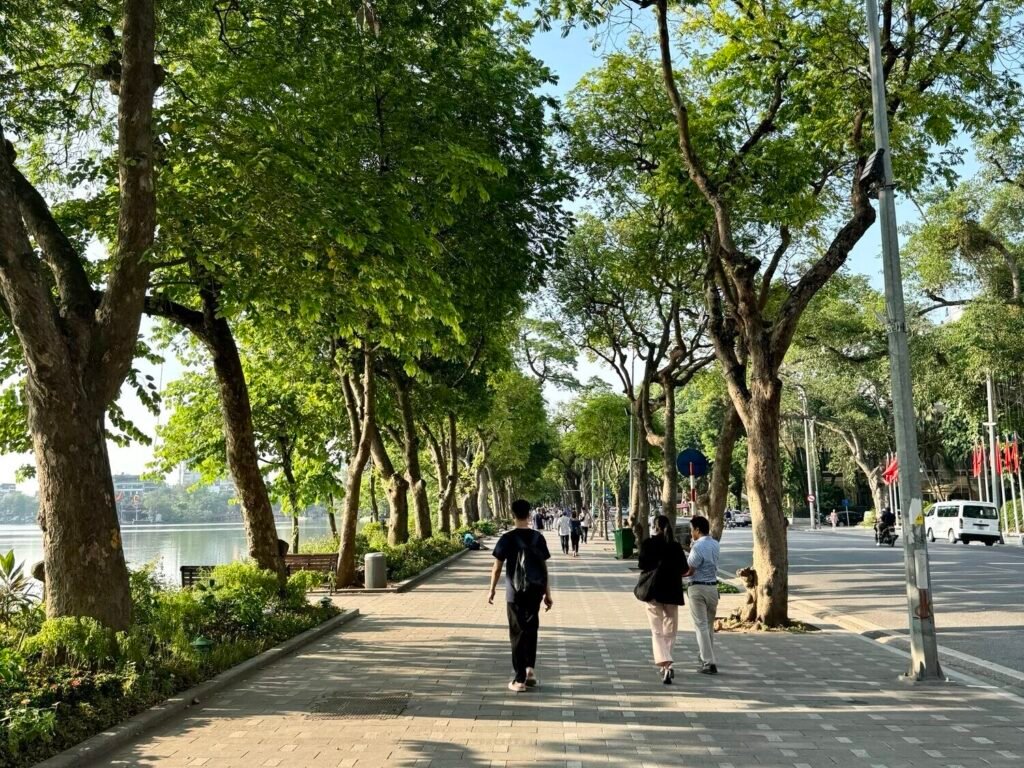
Must-Do Activities:
- Stroll around Hoan Kiem Lake: Enjoy a peaceful escape in the heart of bustling Hanoi and visit the Temple of the Jade Mountain, a charming temple on Hoan Kiem Lake’s island, accessed via the iconic red Huc Bridge.
- Wander through the Old Quarter/French Quarter: These vibrant areas, with their narrow streets and colonial architecture, are perfect for immersing yourself in Hanoi’s culture. Explore unique shops, enjoy local street food, and indulge in some of the city’s best people-watching.
- Explore the Temple of Literature: Vietnam’s first national university, this well-preserved site is dedicated to Confucius and offers a fascinating look at Vietnam’s academic past and traditional architecture.
- Visit Tran Quoc Pagoda: Hanoi’s oldest Buddhist temple, located on a small island in West Lake. Its iconic 11-story red pagoda makes it a must-visit spiritual landmark.
- Admire St. Joseph’s Cathedral: A stunning neo-Gothic gem that evokes the design of Paris’s Notre-Dame and serves as a testament to Hanoi’s French colonial history.
- Explore Hoa Lo Prison Museum: Known as the “Hanoi Hilton,” this historical site provides a sobering glimpse into Vietnam’s turbulent past, highlighting the resilience and struggles of those who were imprisoned here.
- Visit Train Street: Experience the thrill of standing just feet away from a passing train as it weaves through narrow residential streets. Be sure to check the schedule for train times to witness this unique phenomenon safely.
- See the Hanoi Opera House: An elegant French colonial building that stands as a striking example of classical European architecture in Vietnam.
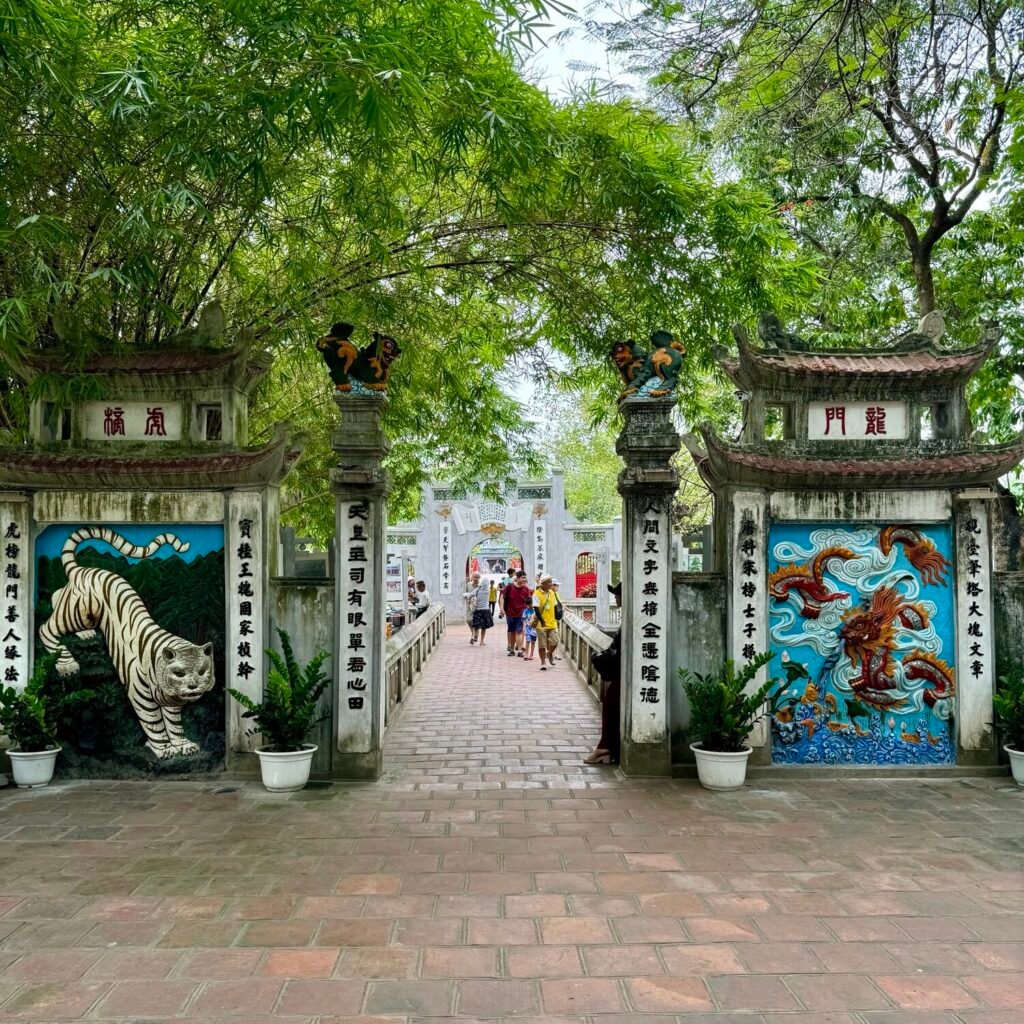
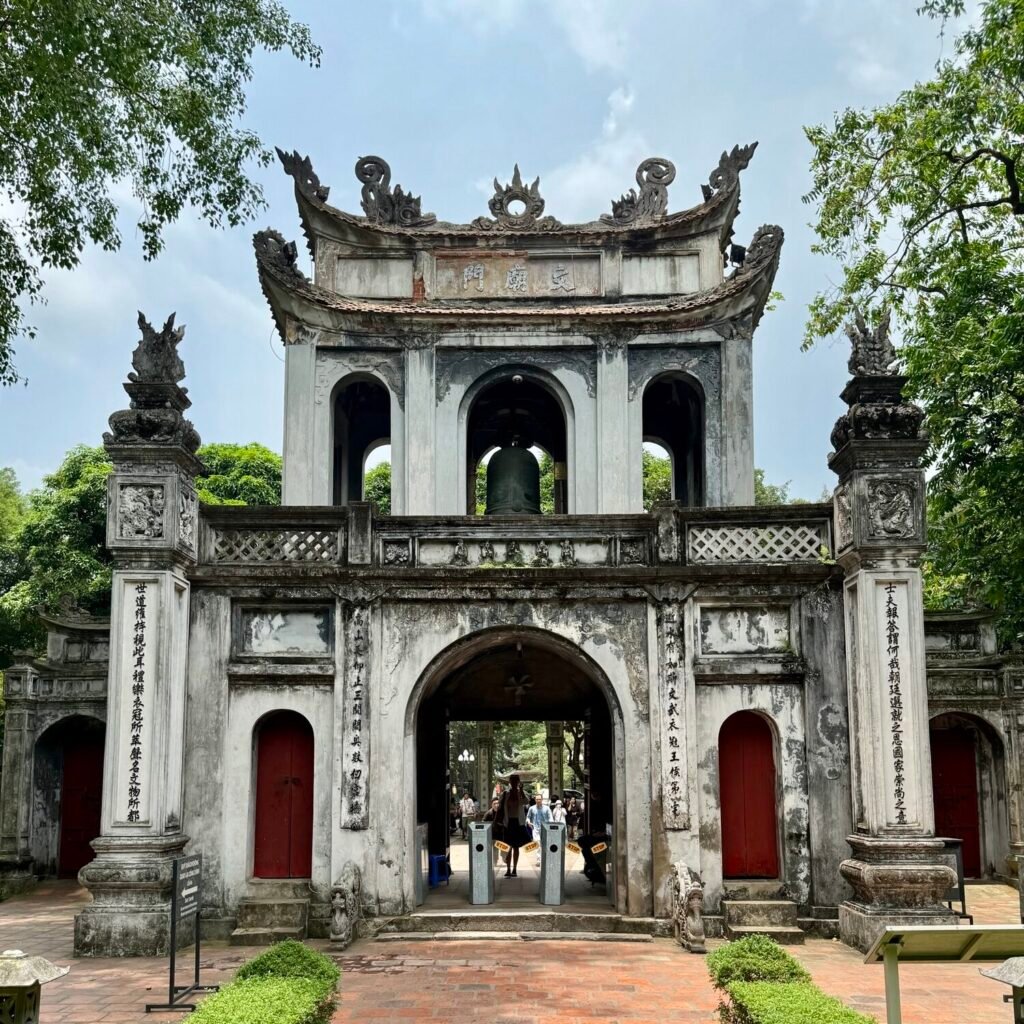


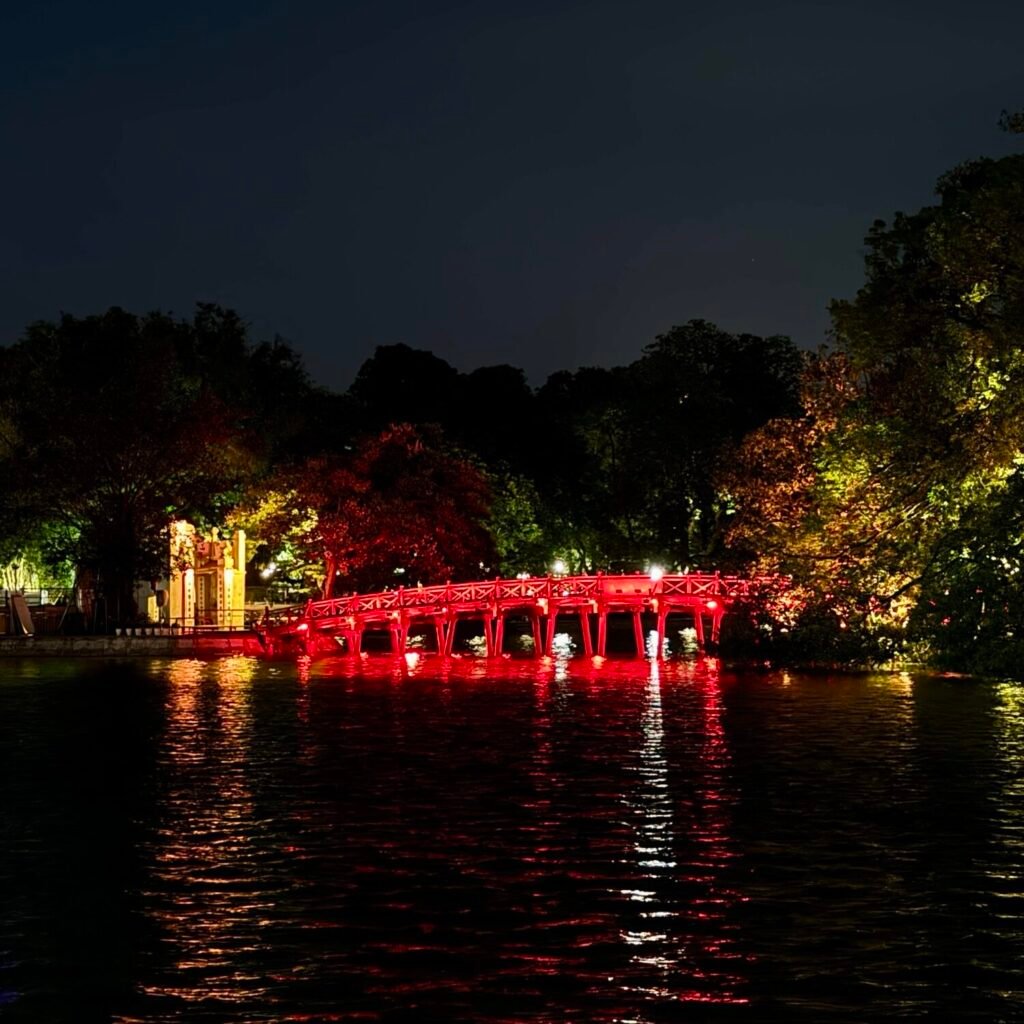
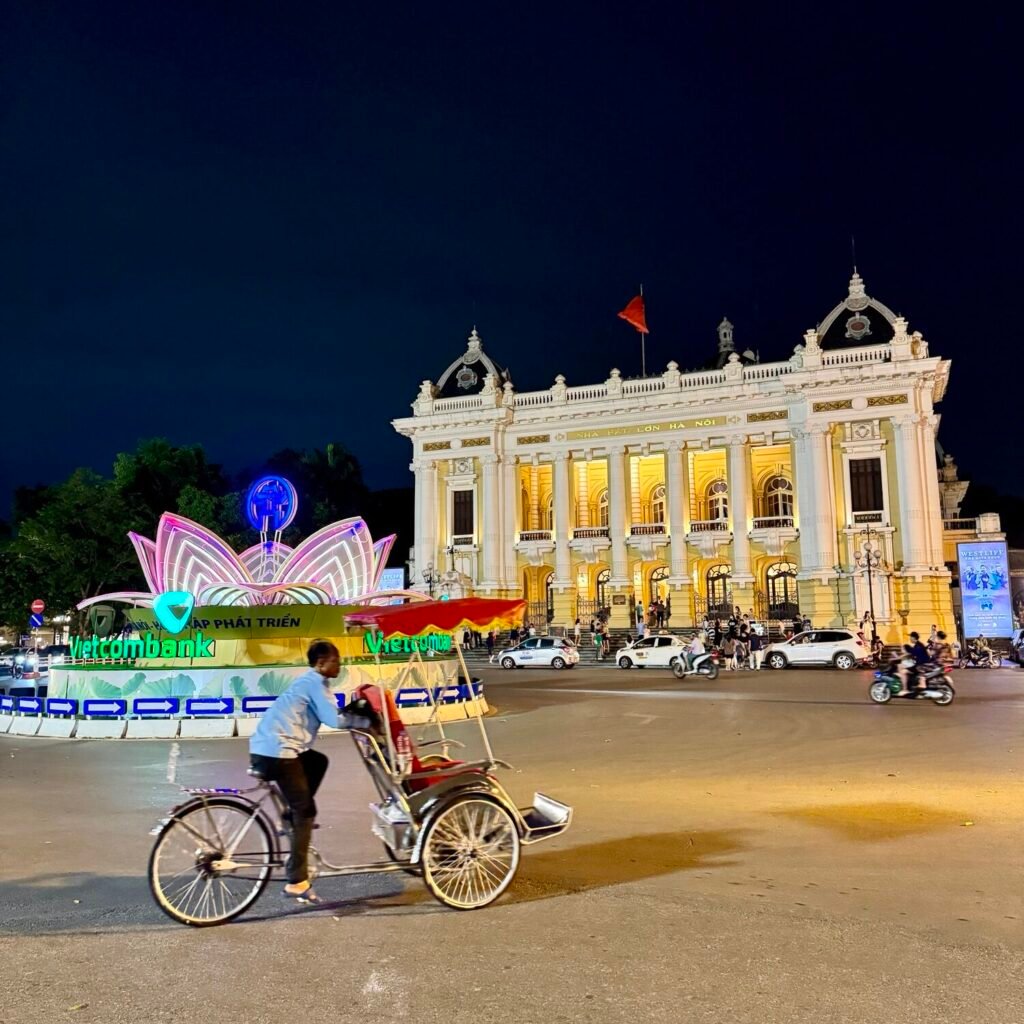
Must-Eat Foods:
- Pho: Savor a steaming bowl of this iconic Vietnamese noodle soup at a local street stall. In Hanoi, “beef pho” (pho bo) is considered the traditional choice, offering a rich and hearty flavor from its slow-cooked beef broth, while “chicken pho” (pho ga) provides a lighter option with its delicate, aromatic chicken broth.
- Banh Mi: Relish a crispy baguette sandwich filled with grilled pork, pate, or a mix of fresh herbs and vegetables. Hanoi’s take on this classic sandwich seamlessly blends French and Vietnamese influences, making it an essential part of the local culinary experience.
- Egg Coffee (Cà phê trứng): Treat yourself to this Hanoi specialty—a rich and creamy coffee made with whipped egg yolks, sugar, and condensed milk. A perfect dessert-like treat, it’s a must-try for coffee lovers seeking something unique.
- Bun Cha: A quintessential Hanoi dish featuring grilled pork patties, vermicelli noodles, fresh herbs, and a tangy dipping sauce. For the ultimate experience, pair it with crispy fried spring rolls on the side.
- Cha Ca La Vong: Originated in Hanoi in the 19th century, this traditional Vietnamese dish showcases turmeric-marinated fish stir-fried with dill, green onions, and other seasonings, served with rice noodles, peanuts, and fresh herbs.
- Vietnamese Iced Coffee with Condensed Milk (Cà phê sữa đá): Cool off with this bold and sweet coffee creation. Its robust flavor, balanced by creamy condensed milk, makes it an essential Hanoi pick-me-up.
- Xoi Xeo: A simple yet satisfying dish of sticky rice topped with mung bean paste and crispy fried shallots. Often served with roasted chicken or pork, it’s a hearty and flavorful breakfast favorite in Northern Vietnam.
- Durian Coffee: For the adventurous foodie, try this unique blend of robust coffee and durian’s distinct, creamy sweetness. While polarizing, it’s a memorable experience for those willing to embrace this Southeast Asian delicacy.
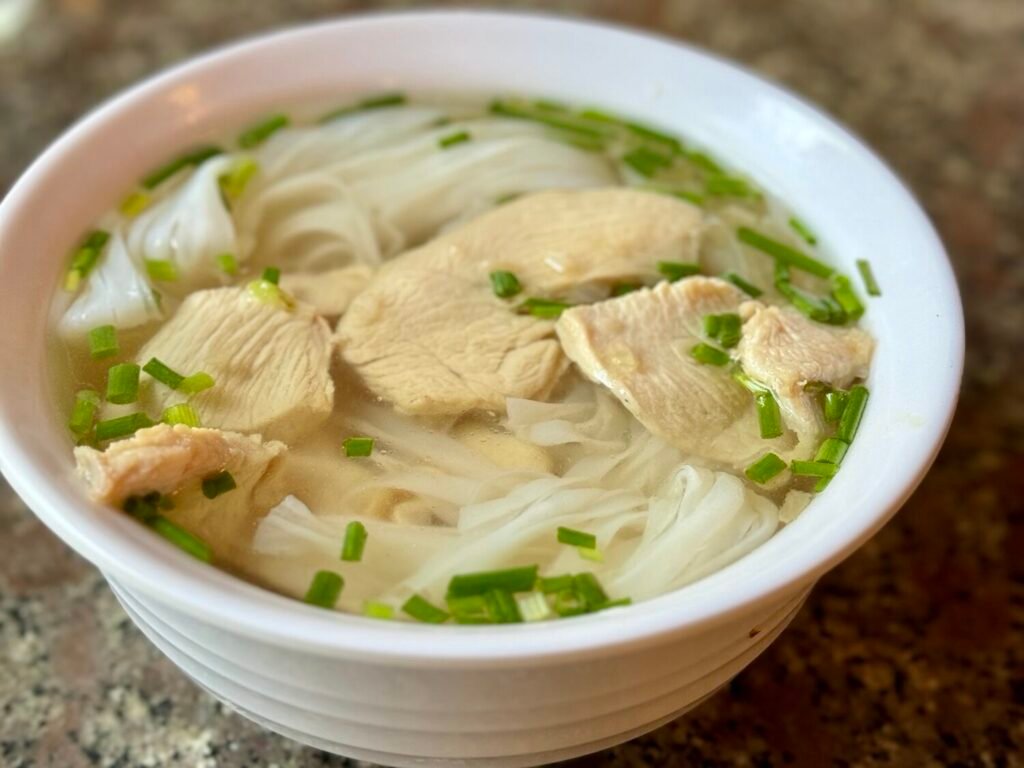


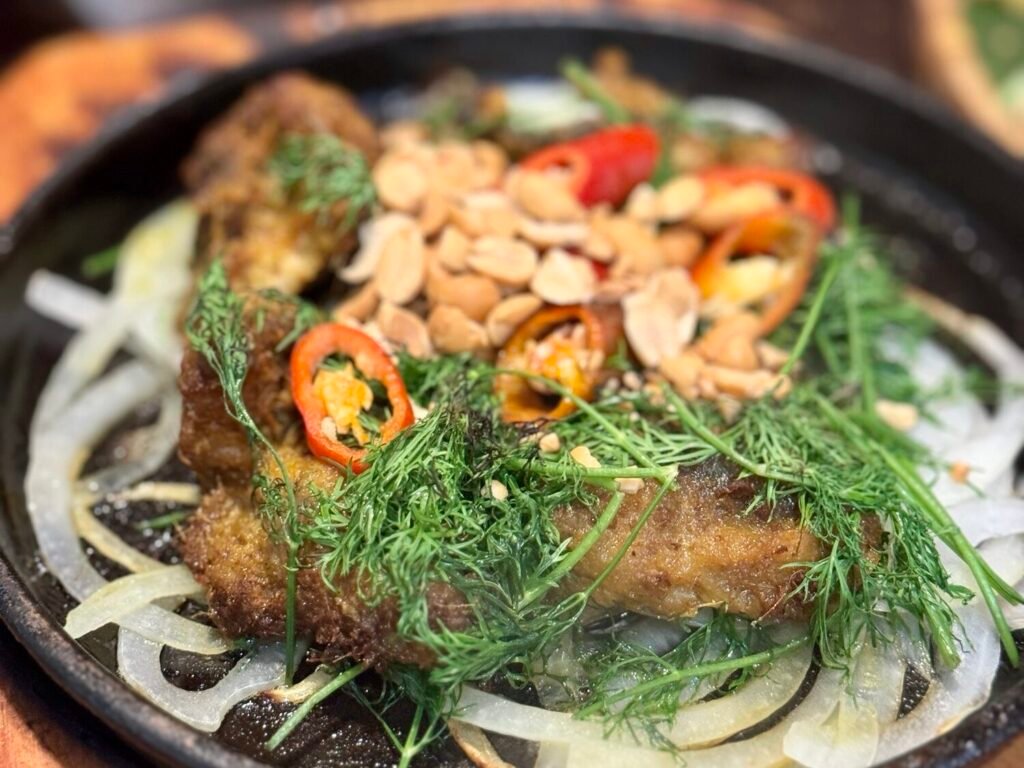
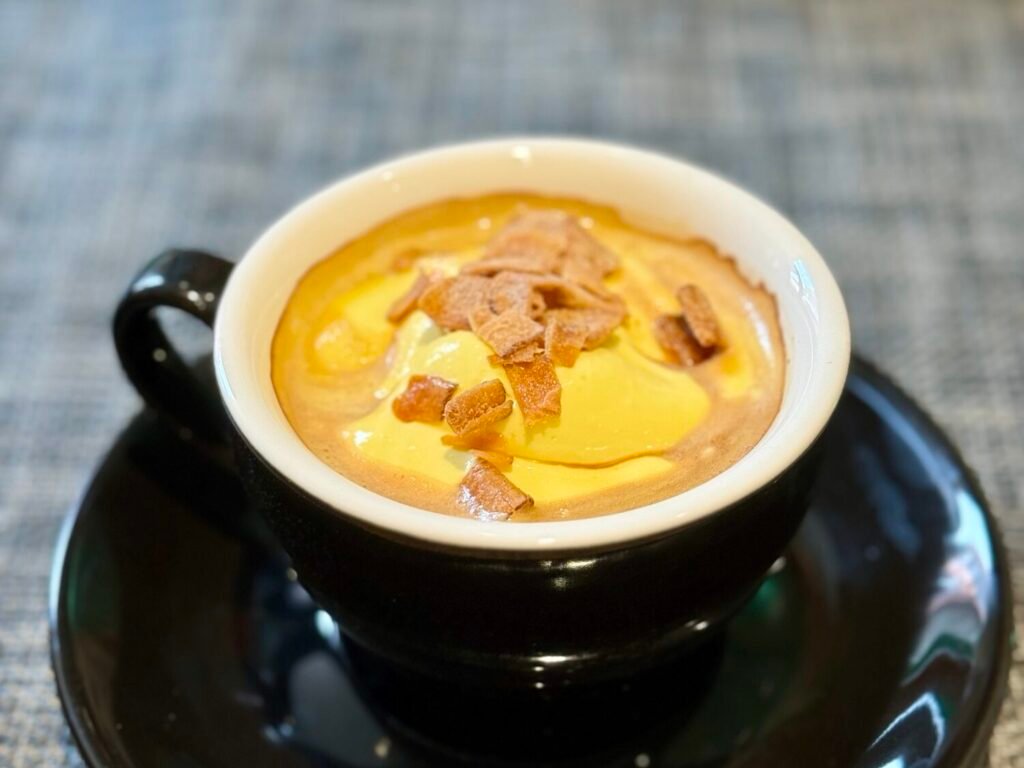
4. Hoi An: Lantern-Lit Riverside Charm (★★★★☆)
Suggested Time: 2-3 Days
Hoi An’s Ancient Town, a UNESCO World Heritage Site, captivated us with its enchanting lantern-lit streets and riverside charm. While undeniably vibrant, the heavy crowds in the Ancient Town slightly tempered its magic compared to the serene and quieter atmosphere of destinations like Tam Coc.

Must-Do Activities:
- Tour the Hoi An Ancient Town: Step back in time as you explore traditional architecture and historic sites. Highlights include the Phuc Kien Assembly Hall, Tan Ky House, and the Temple Honoring Guan Yu. Don’t miss a traditional music performance at the Hoi An Museum of History and Culture.
- Attend the Hoi An Memories Show: This captivating cultural performance offers a grand display of history, culture, and traditional Vietnamese music and dancing. It reminded us of the famous “Impression Liu Sanjie” show in China and is a must-see for culture enthusiasts.
- Craft Your Own Lantern: Join a traditional Vietnamese Lantern Making Class to create your own Hoi An lantern. We booked this “Hoi An: Vietnamese Foldable Lantern Making Class” experience on GetYourGuide and had a fantastic experience.
- Take a Coconut Boat Ride: Visit Cam Thanh Coconut Village and hop into a basket boat for a wild spinning ride—imagine theme park teacups on water! It’s a thrilling and fun activity for all ages.
- Join a Vietnamese Cooking Class: Learn local culinary techniques in a hands-on experience. We booked the Hoi An Tropical Cooking Tour and highly recommend it. The tour combined visiting the local wet market to pick fresh ingredients, a coconut boat ride, and a cooking class where we prepared four flavorful Hoi An dishes. The delicious and unique flavors were unlike anything we’d ever tasted before.

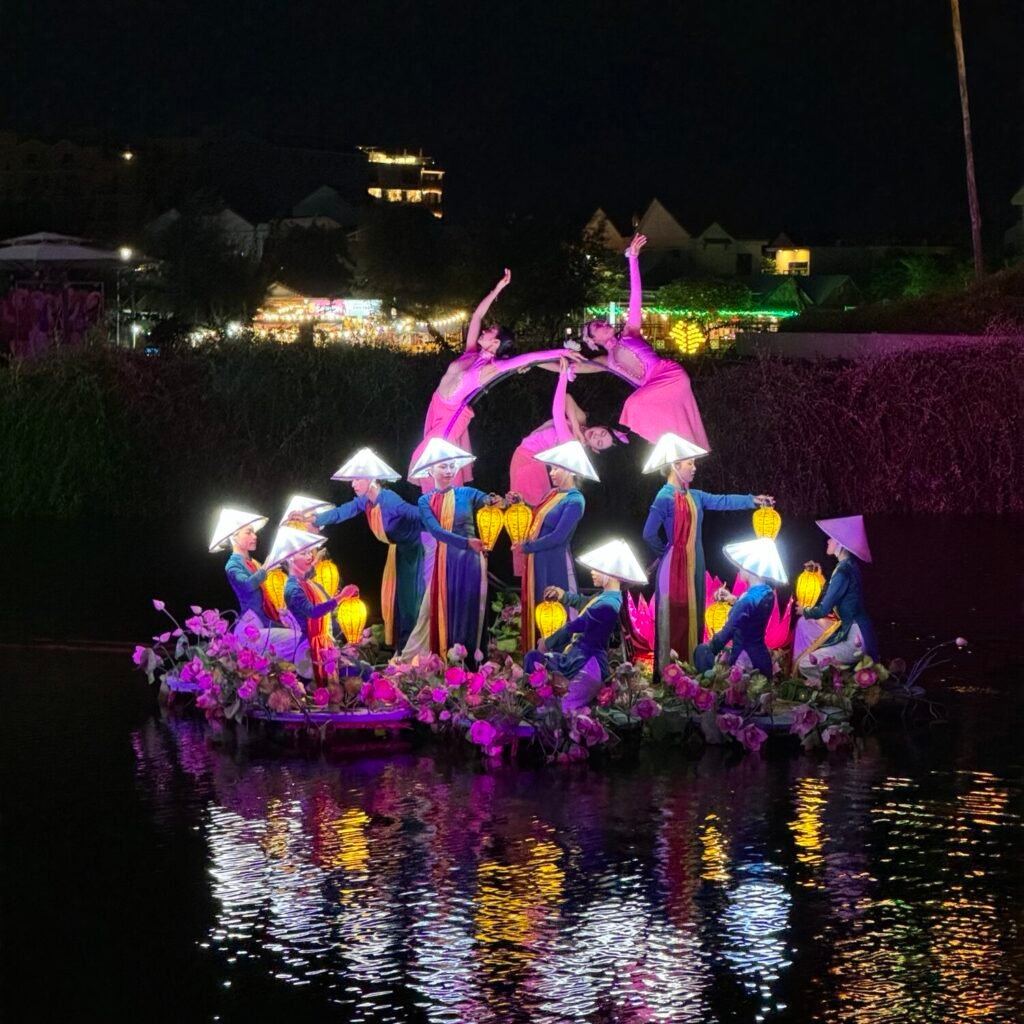
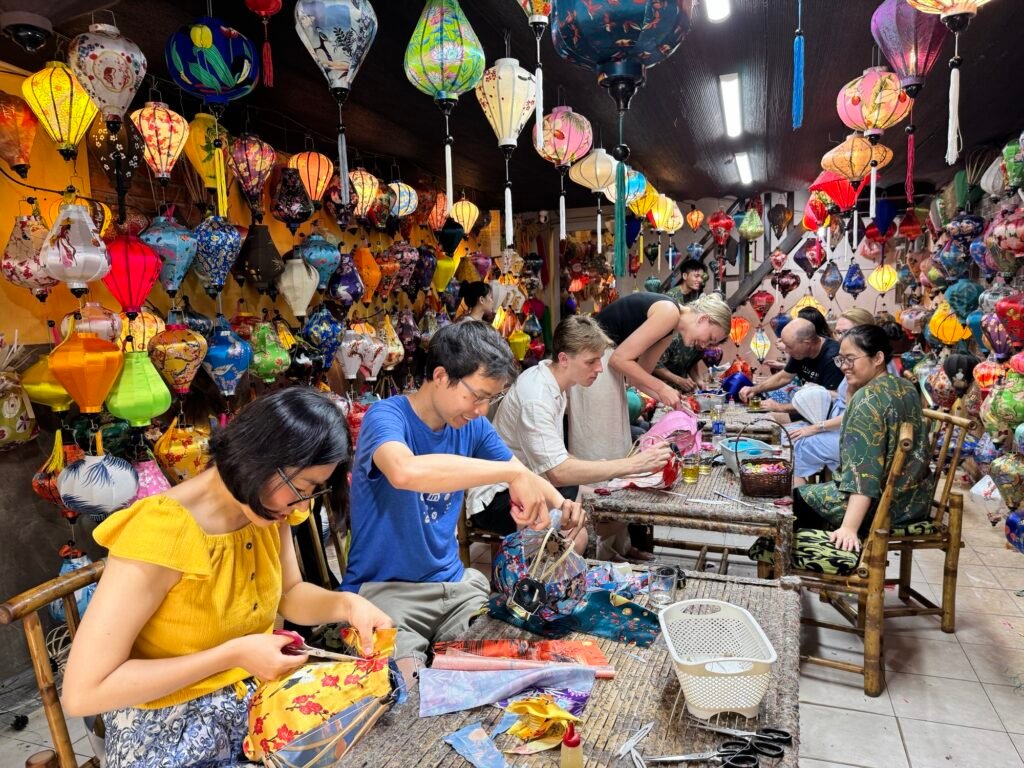


Must-Eat Foods:
- Vietnamese Chicken Rice (Cơm Gà Hội An): A signature Hoi An dish, this flavorful meal combines shredded chicken tossed with Vietnamese coriander, onions, and tangy lime dressing, served with fragrant turmeric rice cooked in rich chicken stock—a must-try in Hoi An.
- Cao Lau: A noodle dish unique to Hoi An, featuring chewy noodles, fresh greens, and savory pork.
- Mi Quang: tender turmeric noodles topped with shrimp, pork, quail eggs, and a variety of fresh herbs, served with a warm, flavorful broth.
- White Rose Dumplings: A local delicacy of translucent dumplings filled with shrimp and topped with crispy garlic.
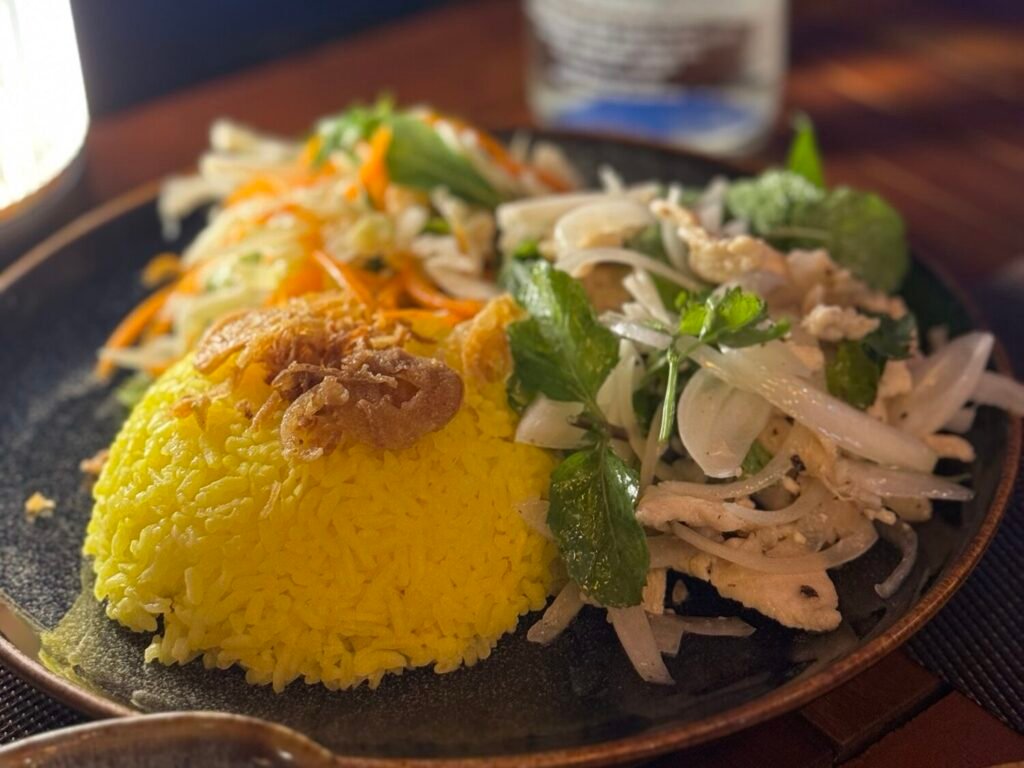
5. Da Nang: Vietnam’s Coastal Gem (★★★★☆)
Suggested Time: 2-3 Days
First Impressions? Da Nang feels like the Hawaii of Vietnam to us, with its contemporary vacation vibes and a perfect mix of relaxation, culture, and adventure.

Must-Do Activities:
- Visit the surreal Golden Bridge at Ba Na Hills: Perched in a mountain amusement park near Da Nang, this iconic bridge, held up by giant stone hands, was just as stunning in person as we had imagined. The cable car ride to reach the bridge, passing through lush mountains and cascading waterfalls, was an unforgettable experience in itself.
- Explore Marble Mountain: A breathtaking religious site featuring ancient Buddhist temples hidden within massive caves, Marble Mountain also offers panoramic views of the coastline and city that are truly awe-inspiring.
- Watch the Dragon Bridge light up at night: This striking modern landmark, known for its fire-breathing shows on weekends, is a favorite hangout spot for locals and added a touch of whimsy to our time in Da Nang.
- Stroll along My Khe Beach: Spend a relaxing evening enjoying the soft sands and calming sea breeze at this beautiful coastal stretch.

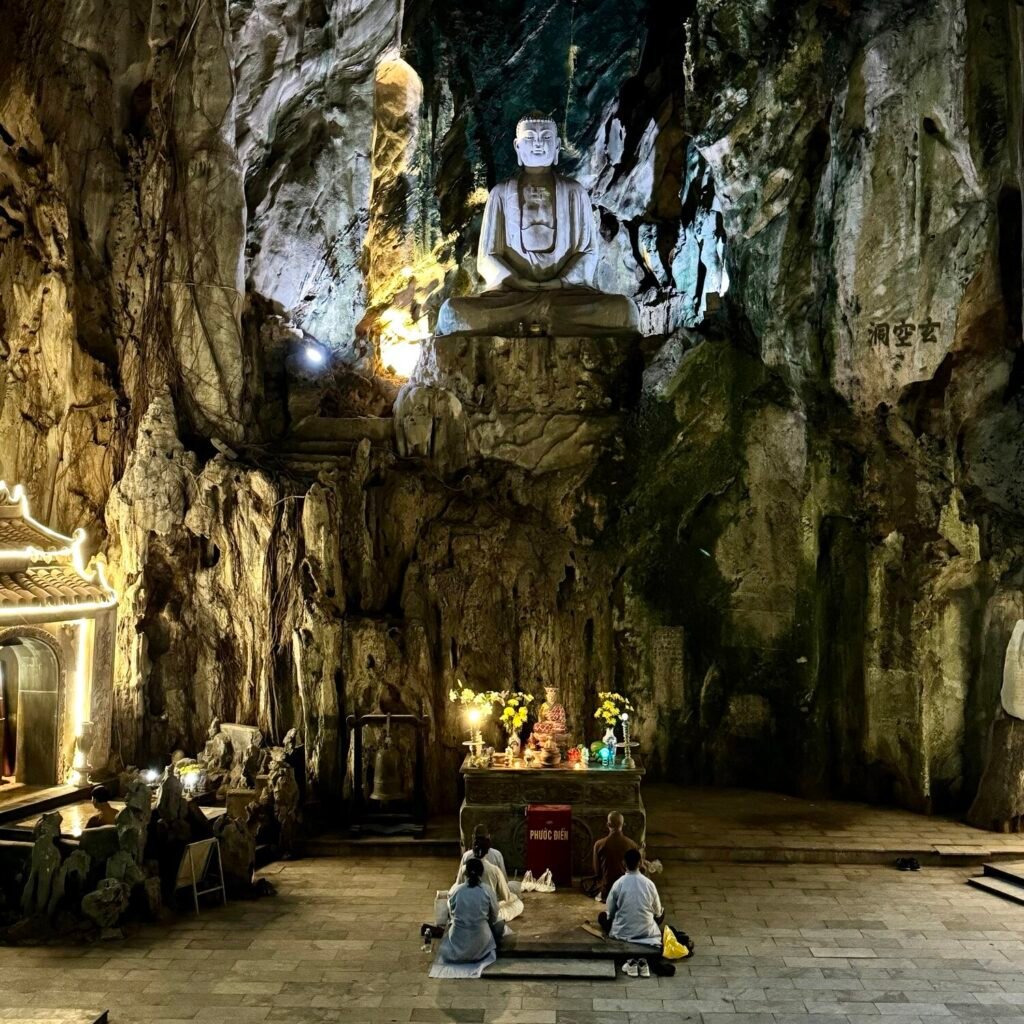
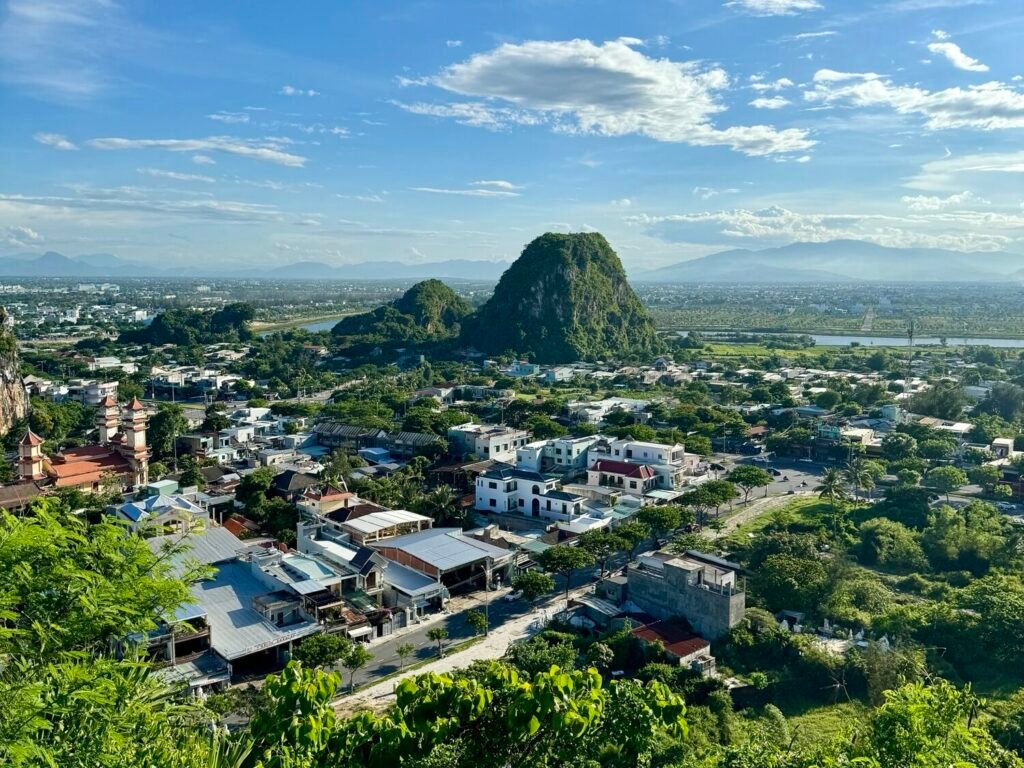
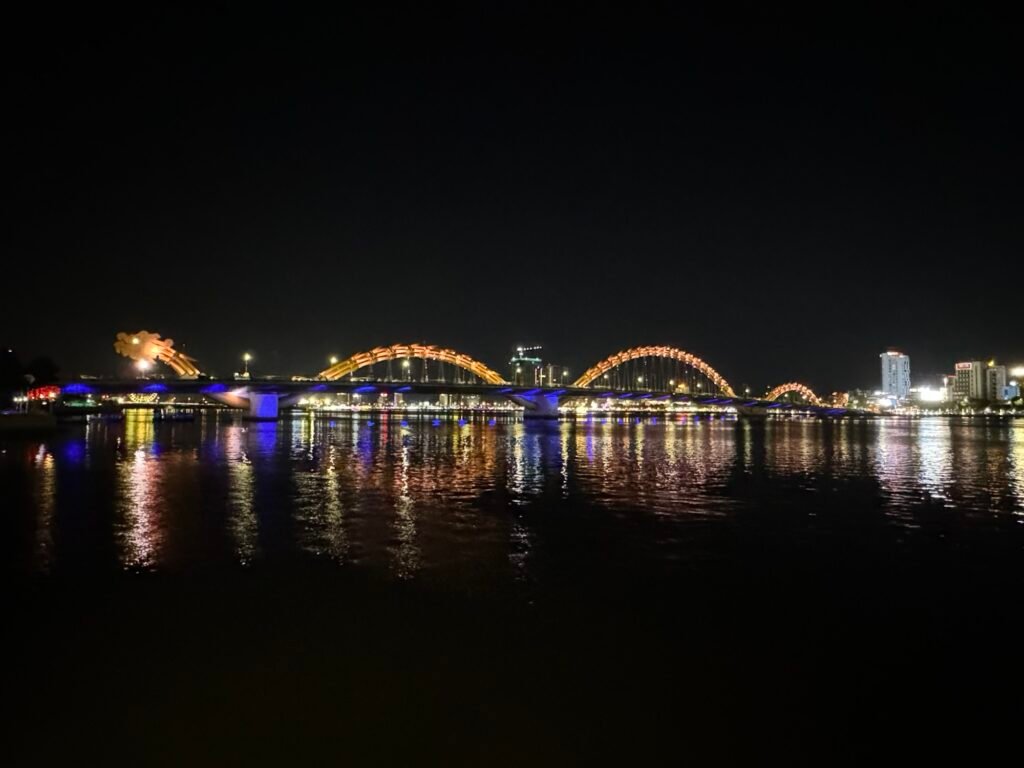
Must-Eat Foods:
Da Nang’s diverse international food scene offers a refreshing change after weeks of savoring traditional Vietnamese cuisine. From authentic Korean soft tofu soup to unique vegan cafes, the city caters to every palate. Of course, don’t miss the chance to try local specialties like Banh Xeo and other regional delights!
Banh Xeo: These crispy Vietnamese pancakes are filled with shrimp, pork, and bean sprouts, making for a light yet satisfying bite that’s bursting with flavor.
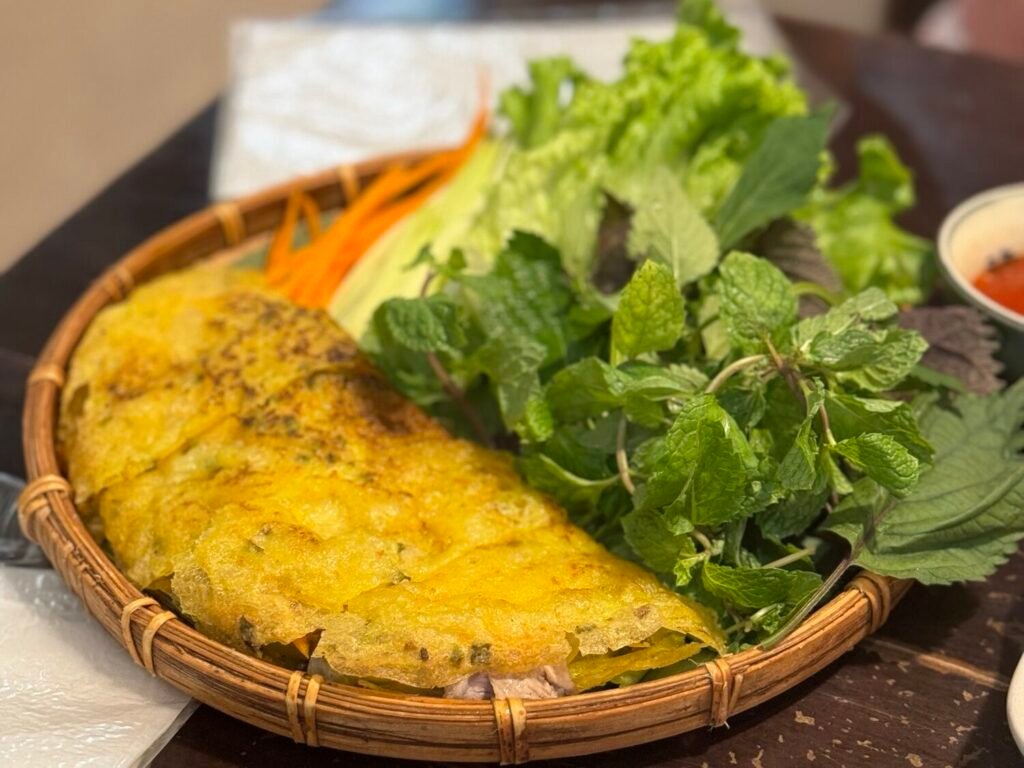
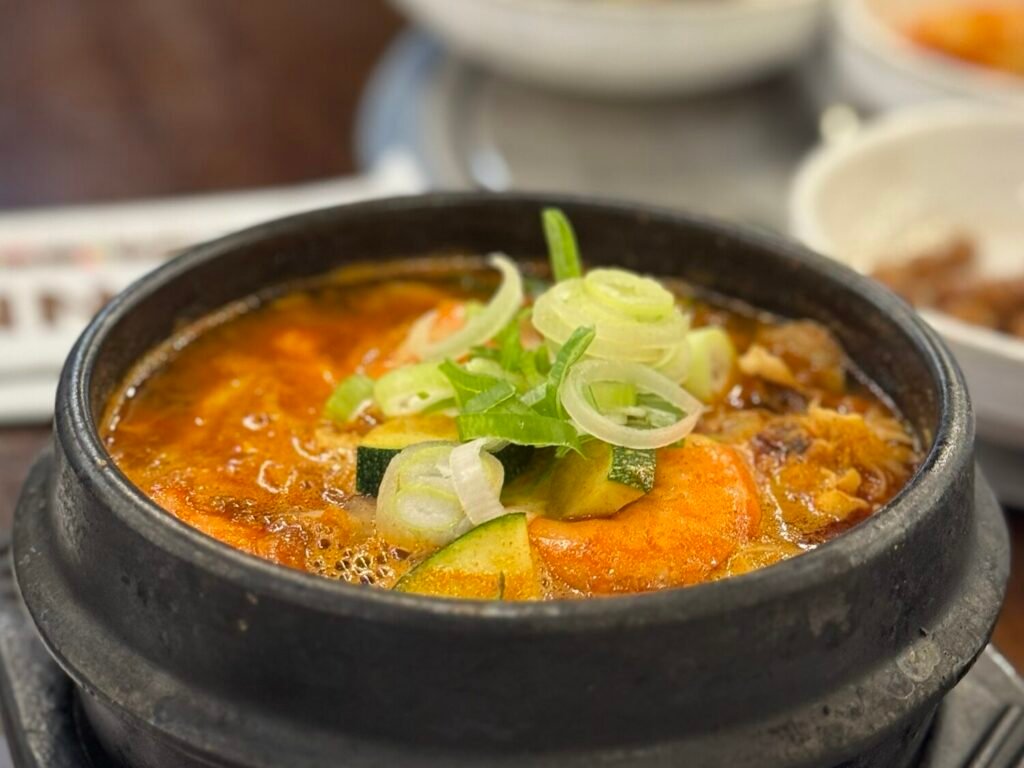
6. Hue: Vietnam’s Imperial Capital (★★★☆☆)
Suggested Time: 1-2 Days
Hue, Vietnam’s former imperial capital, provided a reflective and historical perspective. With fewer international tourists, it felt more authentic and offered a genuine glimpse into Vietnamese life. While Hue is undeniably rich in history, it also felt less dynamic compared to other destinations we explored.
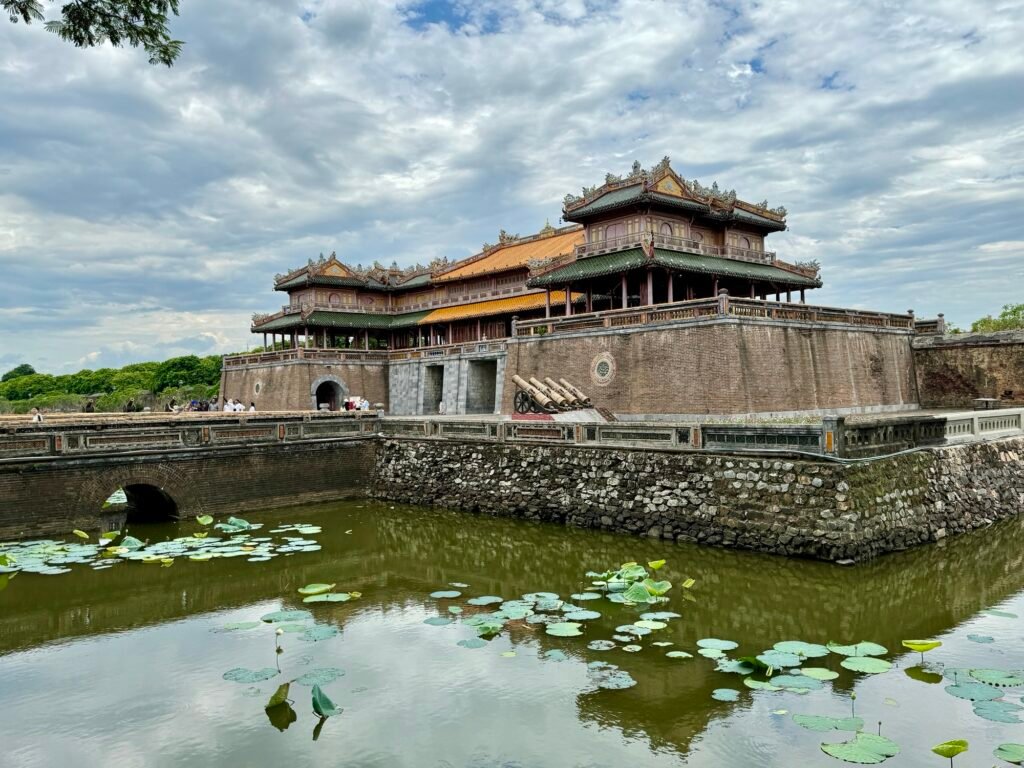
Must-Do Activities:
- Tour the Imperial Citadel: Explore this sprawling complex, reminiscent of Beijing’s Forbidden City. Its grandeur and intricate architecture left a lasting impression, showcasing the opulence of Vietnam’s imperial era.
- Visit the Royal Tombs of Khai Dinh and Tu Duc: These serene, beautifully crafted mausoleums are must-sees for history enthusiasts. The Royal Tomb of Khai Dinh, a UNESCO World Heritage Site, blends traditional Vietnamese and Western architectural styles, showcasing the legacy of Vietnam’s twelfth Nguyễn dynasty emperor. Meanwhile, the Royal Tomb of Tu Duc stands out as the most luxurious, imposing, and unique of all Vietnam’s imperial mausoleums.
- See Thien Mu Pagoda: Perched by the Perfume River, this historic pagoda is one of Hue’s most iconic landmarks and offers a tranquil escape with stunning views.
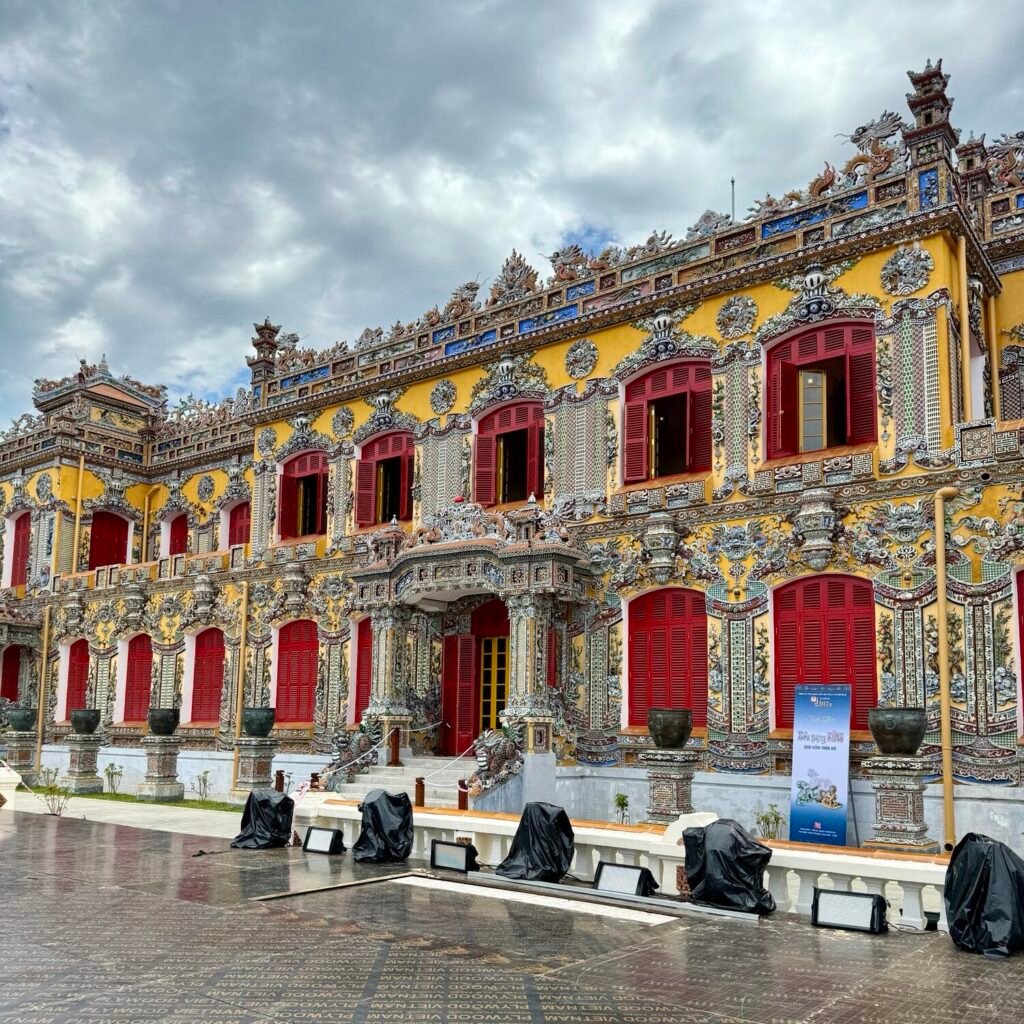
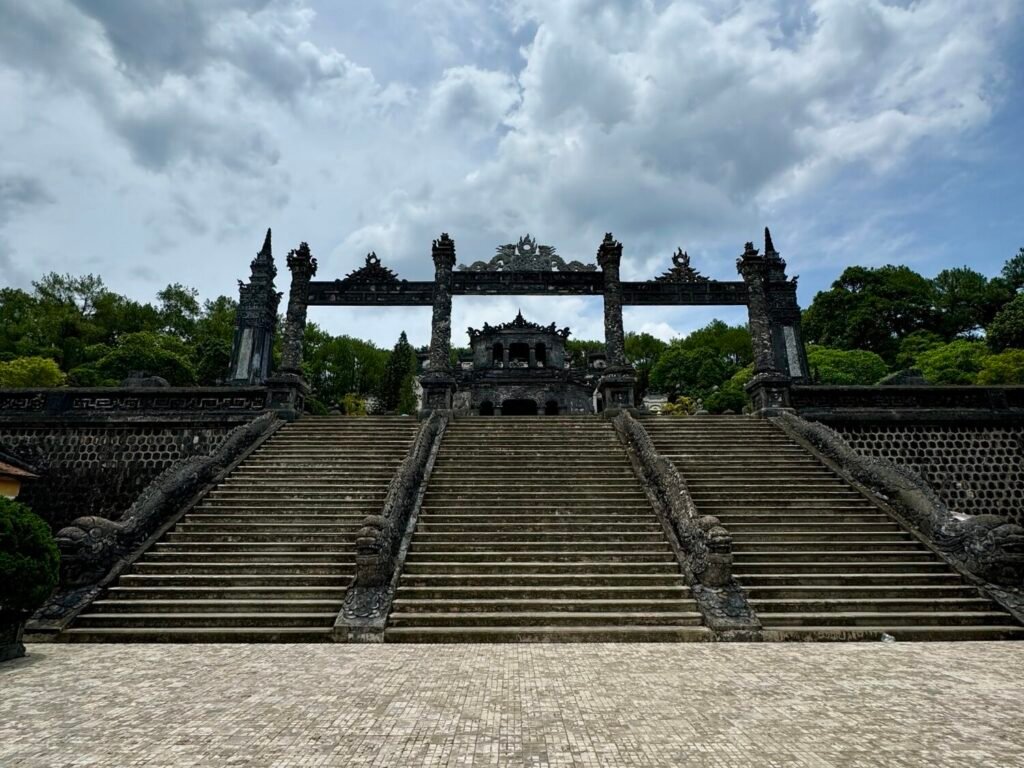

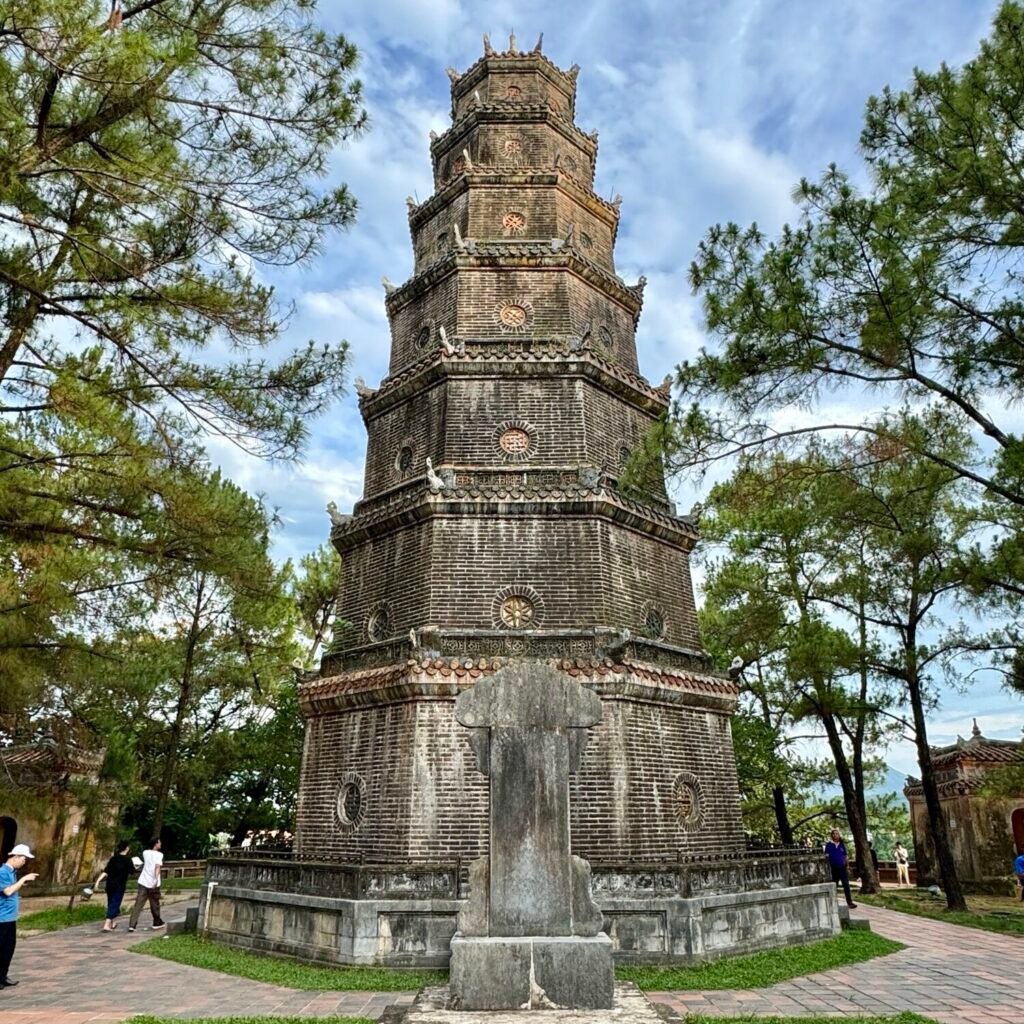
Must-Eat Foods:
- Bun Bo Hue: A spicy and flavorful beef noodle soup native to the region, known for its rich broth and bold spices.
- Nem Lụi: A Hue specialty, this smoky, flavorful dish features marinated pork skewers grilled on lemongrass sticks, served with fresh herbs, rice paper, and a rich peanut dipping sauce.
- Che Hue: A sweet dessert made with beans, coconut milk, and other ingredients, offering a refreshing end to any meal.
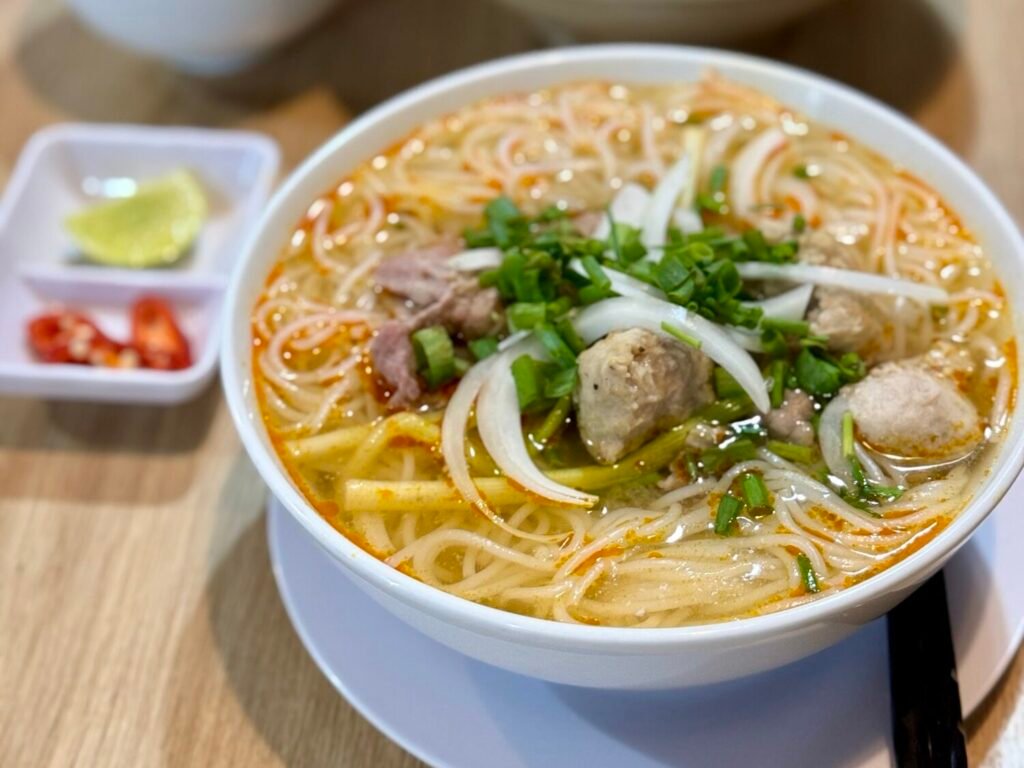

Top 6 Destinations in Northern and Central Vietnam:
Each of the above six destinations showcased a unique facet of Vietnam’s breathtaking beauty, rich culture, and undeniable charm. From the serene landscapes of Tam Coc, where time seemed to stand still, to the vibrant streets of Hanoi buzzing with life and flavor, these experiences left an indelible mark on us. They deepened our connection to Vietnam and created cherished memories we’ll carry with us forever.
Recommended Vietnam Itinerary for First-Timers: Highlights and Overview
Our 16-day Vietnam journey focused on the Northern and Central regions, offering the perfect balance of vibrant cities, serene landscapes, and cultural landmarks. This recommended itinerary highlights the must-see destinations and experiences for first-time visitors to Vietnam, ensuring a seamless and unforgettable trip.
16-Day Vietnam Itinerary for First-Timers
- Day 1: Arrive in Hanoi. Explore Old Quarter and stroll around Hoan Kiem Lake.
- Day 2: Discover Hanoi’s cultural landmarks, including the Temple of Literature, Tran Quoc Pagoda, and more.
- Day 3: Embark on a cruise through Ha Long Bay’s iconic limestone karsts.
- Day 4: Kayak and take in scenic views in Lan Ha Bay, then travel to Tam Coc.
- Day 5: Explore Tam Coc’s lush rice paddies and serene waterways.
- Day 6: Hike up Hang Mua Cave for panoramic views and visit Bai Dinh Pagoda.
- Day 7: Travel to Hue and enjoy a relaxed evening soaking in its quiet charm.
- Day 8: Explore Hue’s imperial past at the Citadel and Thien Mu Pagoda.
- Day 9: Visit the serene royal tombs of Khai Dinh and Tu Duc in Hue.
- Day 10: Head to Hoi An via the breathtaking Hai Van Pass.
- Day 11: Immerse ourselves in the charm of Hoi An’s lantern-lit Ancient Town.
- Day 12: Enjoy a coconut boat ride and take a Vietnamese cooking class.
- Day 13: Relax in Hoi An and attend the grand Hoi An Memories Night Show.
- Day 14: Arrive in Da Nang and visit Marble Mountain.
- Day 15: Experience the whimsical Ba Na Hills and the iconic Golden Bridge.
- Day 16: A peaceful departure day by the beach in Da Nang.
For an in-depth guide to each day, including activities, dining and accommodation recommendations, and practical travel tips, check out my detailed Vietnam 16-Day Travel Itinerary blog post.
Extra Itinerary Tips for First-Timers Planning a Vietnam Adventure
What to Add If You Have Extra Time in Vietnam
If you have extra time to explore Vietnam, consider these additions. Each offers a unique way to deepen your understanding of the country’s beauty and culture, allowing you to slow down and fully immerse yourself in Vietnam’s diverse landscapes and traditions.
- Sapa: Trek through lush, terraced rice fields and visit ethnic minority villages in Northern Vietnam. This mountainous region offers stunning scenery and a glimpse into traditional rural life.
- Phong Nha-Ke Bang National Park: Discover some of the world’s largest and most breathtaking caves, including Son Doong, the largest cave on the planet.
- Ho Chi Minh City: Dive into the bustling energy of Vietnam’s largest city, with its vibrant street food scene, colonial landmarks, and rich history.
- Dalat: Known as the “City of Eternal Spring,” Dalat offers cool weather, flower-filled gardens, and serene lakes. It’s a peaceful retreat in Southern Vietnam.
- The Mekong Delta: Experience the unique river life of Southern Vietnam. Visit floating markets, explore lush waterways, and witness the vibrant daily local lives.
Shorter Vietnam Itinerary Options
If you’re on a tighter schedule, here are some ways to streamline your trip:
- Focus on One Region: Choose a single region that best aligns with your interests and offers the most favorable weather during your travel dates. For example, the North for its dramatic landscapes, or the Central region for its rich history and charming towns.
- Skip or Shoten Hue or Da Nang: Focus your time on exploring Hanoi, Ha Long Bay, Tam Coc, and Hoi An. These destinations offer some of the most unique and quintessential Vietnamese experiences, making them ideal priorities for a shorter trip. See below for a sample 10-day Vietnam travel itinerary with such adjustments:
Sample 10-Day Vietnam Itinerary for First-Timers:
- Day 1-2: Arrive in Hanoi. Explore its vibrant Old Quarter, stroll around Hoan Kiem Lake, and discover Hanoi’s historical and contemporary cultural landmarks.
- Day 3-4: Embark on a 2-day, 1-night luxurious Ha Long Bay cruise. In the afternoon of Day 4, travel to Tam Coc.
- Day 5-6: Explore Tam Coc’s lush rice paddies and serene waterways, hike up Hang Mua Cave, and visit the Bai Dinh Pagoda complex.
- Day 7: Travel to Hoi An via domestic flight (Hanoi -> Da Nang) or private transfer.
- Day 8-9: Immerse in the charm of Hoi An Ancient Town, take a Vietnamese cooking class, and attend the mesmerizing Hoi An Memories Night Show.
- Day 10: Head to Da Nang and depart Vietnam.
Vietnam Travel FAQs for First-Timers: Transportation, Language, Budget, and More
Getting to Vietnam: International Airports and Travel Options
Vietnam’s major international airports are located in Hanoi- Noi Bai Airport (HAN), Da Nang- Da Nang Airport (DAD), and Ho Chi Minh City- Tan Son Nhat Airport (SGN). These hubs are ideal for first-time travelers, offering convenient access to Vietnam’s key regions.
For our trip, we flew into Hanoi’s Noi Bai Airport, which was efficient, well-organized, and perfectly situated for exploring the Northern region. We departed from Da Nang Airport, an equally convenient choice for visiting the Central region. Both airports provided a seamless travel experience and set a positive tone for our adventure.
Exploring Vietnam: Transportation Tips for First-Timers
- Domestic Flights: The fastest way to cover long distances between major cities. For example, during our trip, we flew from Hanoi to Hue to efficiently travel from the Northern region to the Central region. This option saves significant time compared to trains or buses.
- Private Transfers: Many hotels and tour agencies offer private transfer services or can assist in booking via third-party operators. While more expensive than buses or trains, private transfers remain relatively affordable, especially when traveling with friends or family. They are easier to manage, more punctual, and provide a much better overall experience. Popular routes for private transfers include:
- Hanoi to Tam Coc or Ha Long Bay
- Hue to Da Nang or Hoi An
- Hoi An to Da Nang
- Grab: This widely used ride-hailing app is excellent for local transport in urban areas like Hanoi and Da Nang or short-distance travel. Think of it as the “Uber” or “Bolt” of Southeast Asia. For first-time visitors, Grab simplifies navigation, offers an intuitive app interface and affordable rides, and eliminates language barriers when negotiating with traditional taxis.
- Insider Tips: Grab can also be a “lead generator” for long-haul intercity transfers. For example, during our stay in Hue, we used Grab to travel from our hotel to the Imperial City. Impressed by our driver’s cautious and safe driving, we inquired about his experience with longer routes. He had previously driven from Hue to Hoi An and offered a competitive price compared to the private transfer arranged by our hotel. We hired him on the spot for our transfer from Hue to Hoi An the next day.
- Buses: The main budget-friendly option for intercity travel, though they tend to be less comfortable and slower compared to private transfers or flights, and the experience can be chaotic sometimes.
- Trains: While a scenic option for specific routes, such as Hanoi to Sapa, trains are generally slower, with limited schedules and route options. Trains are best suited for travelers with flexible itineraries who value the journey as much as the destination.
Navigating Vietnam’s Traffic for First-Timers: What You Need to Know
Vietnam’s traffic is a fascinating mix of chaos and resourcefulness, shaped by its developing infrastructure and the prevalence of motorbikes. In bustling cities like Hanoi and Ho Chi Minh City, motorbikes dominate the streets, and it’s common to see families of four or five squeezed onto a single bike, often without helmets. Traffic lights are frequently ignored, a reality humorously summed up by a T-shirt we found in Hanoi: “Green light I can go, yellow light I can go, red light I can still go.”
The organized chaos doesn’t stop there. Crossing the road can feel like a real-life challenge, as traffic lights are either absent or disregarded, leaving pedestrians to brave a sea of moving vehicles. Jaywalking is common because, without it, you might wait forever for a clear path. On particularly crowded roads, motorbikes and even cars sometimes bypass traffic by driving into the opposite lanes, creating an added layer of unpredictability.
How to Handle Vietnam’s Traffic for First-Timers:
- Crossing the Road: Follow the locals’ lead—walk steadily and confidently without making sudden stops or changes in direction. Motorists are surprisingly skilled at flowing around pedestrians, so trust the process. If you’re unsure, tag along with a local to cross safely.
- Practice Safety Measures: Always prioritize safety when navigating Vietnam’s traffic. In cars, ensure you wear your seatbelt, even if locals don’t insist on it. If you decide to ride a motorbike, always wear a helmet, despite being told it’s not necessary. Don’t hesitate to refuse a ride—whether in a car or on a bike—if basic safety measures are not in place. Trust your instincts and prioritize your well-being.
- Avoid Self-Driving: Unless you have experience driving in similarly chaotic environments, we do not recommend self-driving in Vietnam. Instead, use Grab (a widely available and affordable ride-hailing app) or hire a private car, which is both convenient and budget-friendly.
- Check Long-Haul Drivers: For long-distance travel, validate the driver’s credentials and reviews beforehand to ensure they are experienced, diligent, and safety-conscious. This will give you peace of mind during your trip.
- Get Travel Insurance: It’s important to have travel insurance with good medical expense coverage. Vietnam’s traffic can be unpredictable, and having insurance ensures you’re protected in case of an accident or medical emergency.
- Stay Alert: If you’re a passenger in a car or on a motorbike, be prepared for unconventional maneuvers, like vehicles driving into the opposite lanes to bypass traffic. Stay aware and expect the unexpected.
- Embrace the Experience: While it may feel overwhelming at first, viewing Vietnam’s traffic as part of its charm will help you appreciate its unique rhythm. Over time, the chaos becomes a memorable part of your adventure.
Traveling in Vietnam for the First Time with Just English: What to Expect
If you only speak English, don’t worry—you’ll still find it relatively easy to travel in Vietnam. English is widely spoken in the tourist industry, especially in major cities, hotels, restaurants, and popular tourist destinations like Ha Long Bay, Hoi An, and Da Nang. Tour guides, reception staff, and many vendors are accustomed to communicating with international visitors in English.
However, in rural or off-the-beaten-path areas, English proficiency can be limited. To overcome this, consider using apps like Google Translate or pre-learning a few simple Vietnamese phrases (such as greetings and thank yous) to make interactions smoother and show respect to the locals. These small efforts can greatly enhance your travel experience!
Staying Healthy: Food Safety Tips for Your First Vietnam Adventure
Ensuring food safety is essential for a worry-free and enjoyable trip to Vietnam. Here are some essential tips you need to know about staying healthy while savoring Vietnam’s incredible cuisine.
Drink Smart:
- Tap Water: Avoid drinking tap water as it’s unsafe due to possible contamination. Stick to bottled water with intact seals or boiled water for drinking. While we personally had no issues using tap water to brush our teeth, it’s a cautious practice to use bottled water instead.
- Ice: Most ice in urban areas is made from purified water and is generally safe. However, in rural regions or less reputable establishments, ice may be made from untreated water. Exercise caution. When in doubt, request drinks without ice.
Choose Food Wisely:
- Street Food: Vietnam’s street food is a must-try, but hygiene standards can vary. Choose vendors or restaurants with positive reviews and high customer turnover, which often signal fresh ingredients and good cleanliness.
- Raw Food Caution: Consuming raw or undercooked meats, seafood, and unwashed vegetables carries a significant risk of foodborne illnesses. Always opt for thoroughly cooked dishes, and ensure fruits and vegetables are properly washed or peeled. Whenever possible, peel fruits yourself to minimize risks. If raw salads or pre-peeled fruits are your only options, choose establishments with a strong reputation for hygiene. As a precaution, we strongly recommend avoiding raw meats and seafood altogether while in Vietnam.
Practice Good Hygiene and Be Prepared:
- Carry and use hand sanitizer before meals if handwashing facilities are unavailable.
- Ensure food handlers use clean utensils or gloves when preparing your meal.
- Pack over-the-counter medications, like antidiarrheal drugs, to address digestive issues if they arise.
- Purchase travel insurance that includes coverage for health-related emergencies.
By following these practical tips, you can enjoy Vietnam’s world-renowned cuisine while staying safe and healthy. Let the flavors of Vietnam add unforgettable moments to your journey, worry-free!
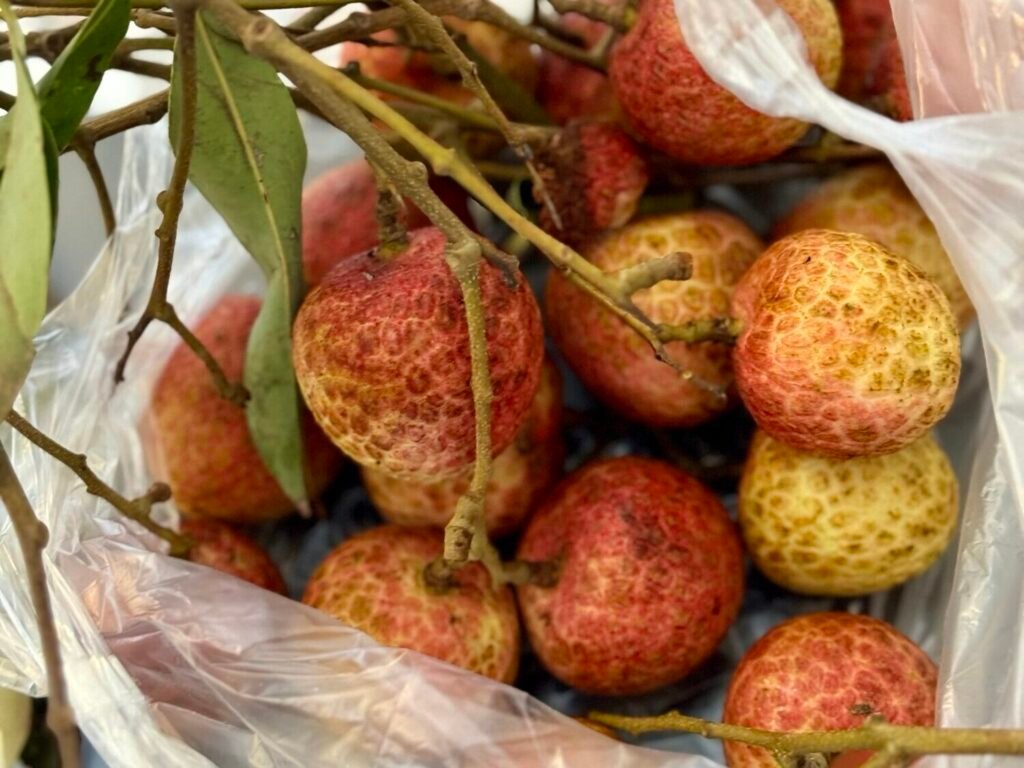
Money in Vietnam: Essential Tips for First-time Travelers
When traveling in Vietnam, it’s essential to understand the local currency and payment methods to ensure smooth transactions throughout your journey.
Currency: The official currency is the Vietnamese Dong (VND), symbolized as ₫. Banknotes come in denominations ranging from 200 VND to 500,000 VND. Coins are not in circulation.
Cash is Essential: Cash remains the predominant payment method, especially in rural areas, local markets, street vendors, smaller establishments, private transfer and other local transportation services, ticketing for tourist attractions, and local tour agencies.
Credit and Debit Cards: While the acceptance of credit and debit cards is increasing, they are primarily accepted only in urban centers, larger restaurants, large retailers, and major hotels. However, some may apply a surcharge (2% to 5%) for card payments. It’s prudent to inquire about any additional fees before completing a transaction.
Mobile Payments: The use of digital wallets like MoMo, VNPay, and ZaloPay is on the rise, especially in urban areas. However, their acceptance is not yet universal, and cash remains king in many parts of the country.
How to Get Cash in Vietnam?
- ATMs: ATMs are widely available in cities and towns, although not all ATMs accept international cards. Withdrawal fees typically range from 20,000 to 50,000 VND per transaction, though some banks like TPBank and VPBank offer fee-free withdrawals. You should also check with your home bank about any additional fees they may impose on international withdrawals and the exchange rate they use for conversion.
- Currency Exchange: Foreign currency can be exchanged at banks, exchange offices, and authorized counters, including those at international airports. Banks often provide secure transactions with accurate rates, though they may involve longer wait times and potential fees.
Essential Tips for Vietnam First-time Travelers:
- Carry Sufficient Cash: Ensure you have enough cash for daily expenses, especially when traveling outside major cities.
- Notify Your Bank: Inform your bank of your travel plans to prevent any security blocks on your cards.
- Be Aware of Fees: Always ask if there’s an additional fee for using credit cards or withdrawing cash from ATMs to avoid unexpected charges.
- Use Authorized Exchange Services: To avoid scams and unfavorable rates, exchange currency at reputable banks or authorized exchange counters.
- Stay Vigilant: Be cautious of counterfeit currency. Familiarize yourself with the look and feel of genuine VND notes, and consider using a money belt or secure wallet to protect your cash.
By familiarizing yourself with these aspects of Vietnam’s currency and payment methods, you can navigate financial transactions with confidence during your visit.

Budgeting Your Trip: How Much Does It Cost to Travel in Vietnam?
Vietnam is a highly budget-friendly destination. For our 16-day trip in early June 2024, we spent approximately $2,450 USD for two people, excluding international flights to Vietnam. This translates to about $153 USD per day for two people, broken down as follows:
- Accommodation: $1,300 USD ($81 USD/day). This reflected two people sharing one room throughout the trip and a mix of luxurious and mid-ranged stays:
- Luxury overnight cruise in Ha Long Bay/Lan Ha Bay.
- 5-star luxury hotel in Hue.
- 4-star boutique hotels in Hanoi, Hoi An, and Da Nang.
- 3-star local hotel in Tam Coc.
- Transportation: $430 USD ($27 USD/day). This included:
- Domestic flights from Hanoi to Hue.
- Private inter-city transfers for Tam Coc -> Hanoi and Hue -> Hoi An and shared small-group limo van transfers for Hanoi -> Ha Long Bay -> Tam Coc.
- Local transportation within each destination.
- Food: $330 USD ($21 USD/day). This covered lunch and dinner expenses, as most accommodations included breakfast. Vietnam’s vibrant food scene offered delicious and affordable meals, from street food to sit-down dining.
- Experiences and Tours: $290 USD ($18 USD/day). This covered:
- Entrance fees to attractions and performances, including the Hoi An Memories Show, Ba Na Hills, historical sites, and museums.
- Guided tours, such as a cooking class and lantern-making workshop.
- Miscellaneous: $100 USD. This category included souvenir shopping, foot and body massage therapies, and other minor expenses.
Practical Tips for Budgeting Your First Vietnam Trip
- Customize Your Stays: Strike a balance between luxury and mid-range accommodations to enjoy both comfort and affordability. Splurge on a memorable stay, like a luxury Ha Long Bay cruise, and offset costs with more budget-friendly boutique hotels in other locations.
- Maximize Hotel Amenities: Take advantage of complimentary or discounted amenities offered by hotels. Always inquire about your hotel’s available benefits to get the most out of your stay. Many boutique hotels provide excellent perks. For example, in Hoi An, our boutique hotel offered discounts for the Hoi An Memories Show and a complimentary one-way private transfer to Da Nang Airport or city center. In Tam Coc, most hotels include free bike rentals for guests, making it easy to explore the serene countryside.
- Consider Shared Transfers: While private transfers are convenient and affordable, sharing with other travelers can significantly reduce costs. Look for small group or semi-private transfer options, especially for popular routes like Hanoi to Ha Long Bay or Ha Long Bay to Tam Coc.
- Savor Local Eats: Local restaurants and food stalls are a delicious way to experience Vietnamese cuisine and also incredibly wallet-friendly. Seek out popular local eateries with high turnover and good reviews for fresh and authentic meals without breaking the bank.
By incorporating these tips, you can make the most of your Vietnam travel budget while enjoying a comfortable and enriching experience.
Additional Practical Tips for First-time Travelers in Vietnam
Beyond packing your bags, it’s essential to consider practical tips that will enhance your travel experience, keep you safe, and help you navigate the country with ease. Here are some key things to keep in mind as you prepare for your first visit to Vietnam:
- Visa Requirements: Ensure you meet the visa requirements for entry into Vietnam and plan ahead to obtain proper visas. Some nationalities may qualify for visa exemptions or e-visas.
- Consult a Doctor: Seek medical advice on necessary vaccinations or preventive medications before your trip.
- Travel Insurance: Invest in comprehensive travel insurance. If travel insurance isn’t in your budget, it might be wise to reconsider traveling altogether.
- Heat and Hydration: Vietnam’s hot and humid climate can be challenging, even during transitional seasons. Stay hydrated, wear sunscreen, and opt for lightweight, breathable clothing to stay comfortable.
- Mosquito-Borne Diseases: Mosquitoes are prevalent in Vietnam, particularly in tropical and subtropical areas. Use insect repellent and wear protective clothing such as light-colored, long-sleeved shirts and pants for better protection.
- Choose Well-equipped Accommodations: When booking accommodations, ensure they have proper window and door screens and air conditioning to minimize mosquito exposure and stay cool.
- Secure Belongings: Be vigilant in busy markets, public transportation, and tourist hotspots to avoid pickpocketing. Use a money belt or an anti-theft backpack to secure your belongings.
- Photography: Avoid taking photos of military sites or personnel, as this is prohibited.
- Drugs: Drug use and possession are strictly forbidden in Vietnam and carry severe legal consequences.
- Air Quality: Air pollution can be an issue, particularly in major urban centers such as Hanoi and Ho Chi Minh City, or rural regions where trash burning remains common. Bring a mask and take other precautions if you are sensitive to poor air quality.
- Dress Modestly: When visiting temples or religious sites, cover your shoulders and knees to show respect for local customs.
- Tipping: Tipping is not mandatory and is not common in many areas. However, it is appreciated in tourist hotspots for excellent service.
- Respect for Elders: Politeness and showing respect to elders are highly valued in Vietnamese culture.
By following these practical tips, you can navigate Vietnam safely and respectfully, ensuring a more enjoyable and stress-free travel experience.
The End. Happy Traveling!
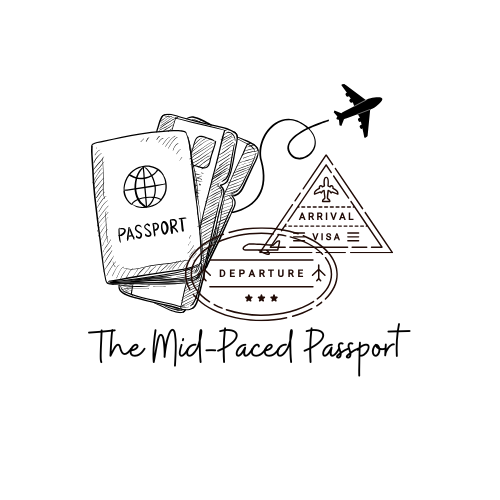



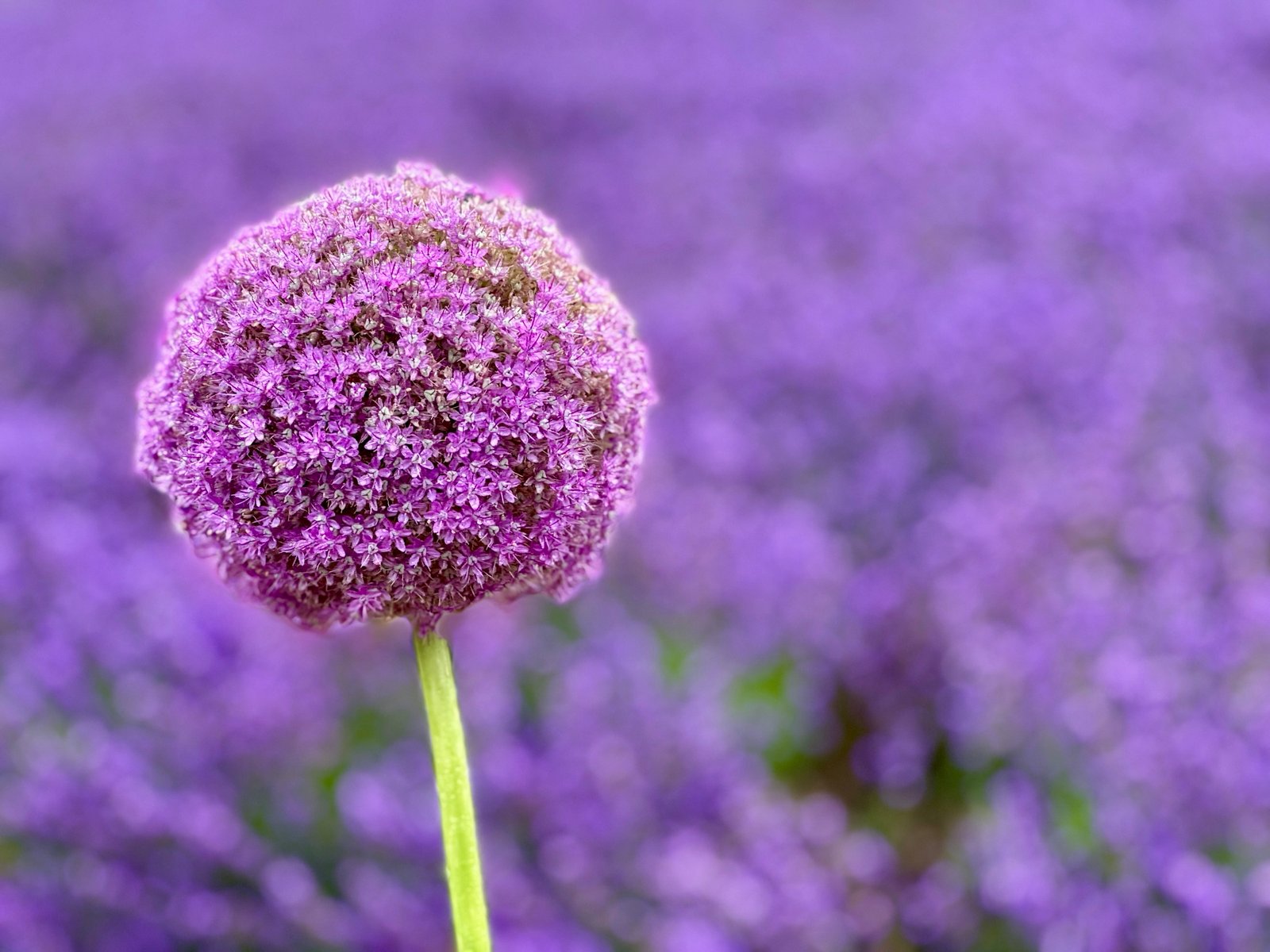

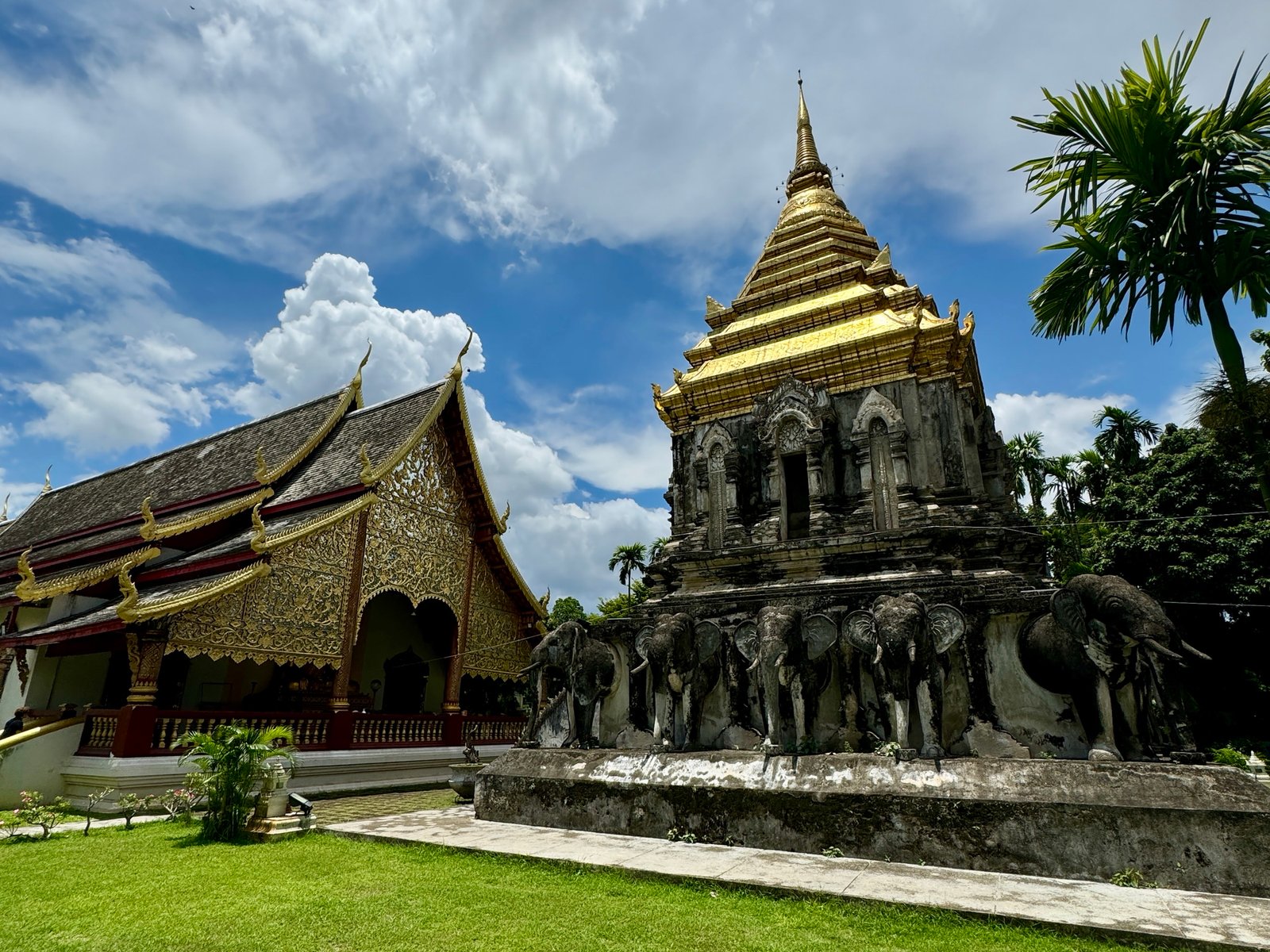
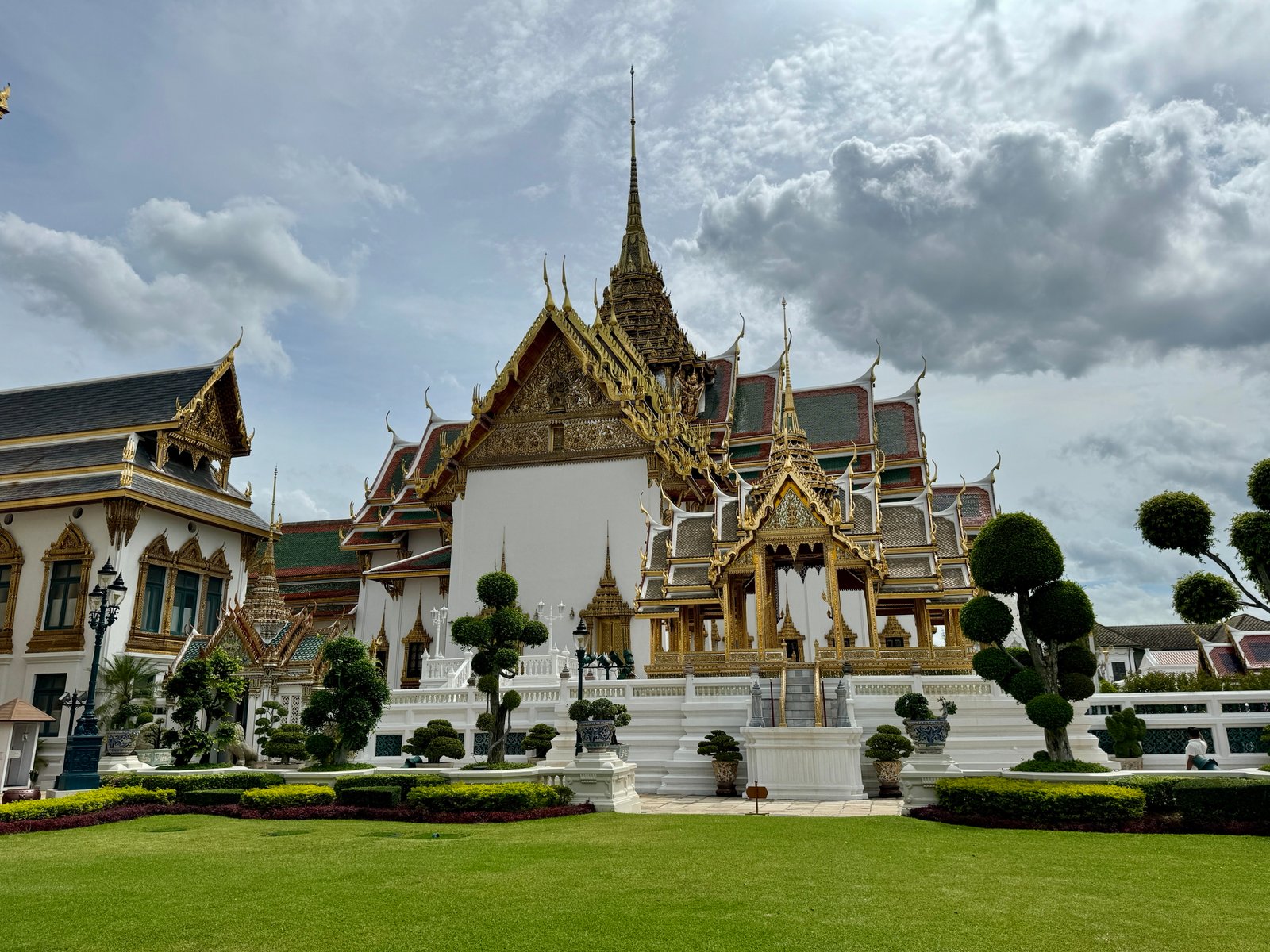

Leave a Reply